Victoria Sadler's Blog, page 12
January 21, 2015
Rubens Exhibition at Royal Academy Is Very Light on Works from, Well, Rubens
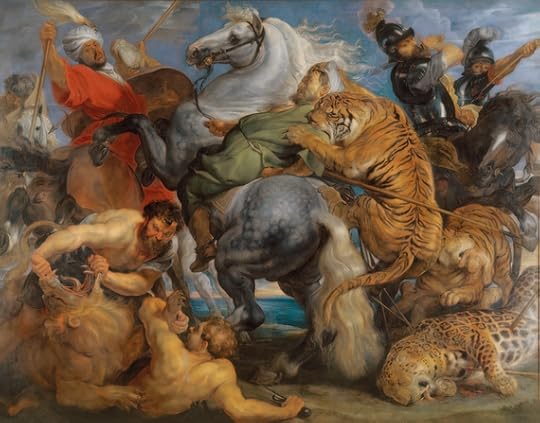
If you are planning to visit the new Rubens and His Legacy exhibition at the Royal Academy, be warned now - there are very few paintings from Rubens on show. Instead this exhibition looks to examine the influence and legacy of this great painter on artists from the period right up to the present day.
The name 'Rubens' may be in the title of the exhibition but I counted maybe only about a dozen works from Rubens actually on show. Maybe a few more. What few Rubens works there are though are incredibly impressive.
Tiger, Lion and Leopard Hunt is an extraordinary piece of work. The piece is full of energy and dynamism as the animals and hunters launch at each other with ferocity - the ultimate battle for survival between these two packs of hunters. There is such a strong sense of chaos, fear and violence in the picture. It's phenomenal.
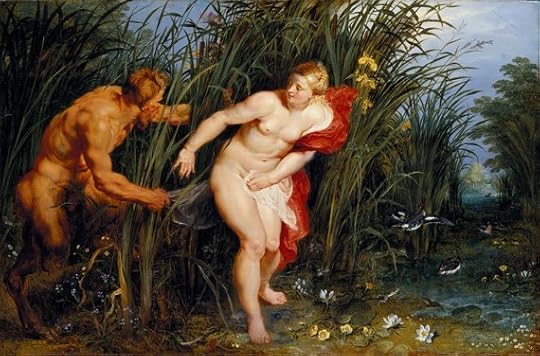
And like all the Rubens works on show, it is hung in a room filled with paintings from other artists on a similar theme - here, Delacroix and Landseer. Though interesting, the other works seem limp by comparison. Maybe that was intentional - putting all the flattery on Rubens - but it does make for a muddling quality of works for an exhibition.
That gulf is particularly acute in the section that looks at Rubens' portraits. One of my favourites, the towering portrait of Maria Grimaldi and Her Dwarf is full of contrasts - the aristocratic woman looks so rested, so wealthy, and her skin peachy and glowing compared to the haggard lines and red eyes of her exhausted servant.
But the portraits from Sir Joshua Reynolds that surround it aren't anywhere near as engaging. The focus of this section is meant to be 'Elegance' (the exhibition is hung thematically) but that's such a generic term - after all, there was plenty of elegant portraits in the RA's own Moroni exhibition from last year. And the impact just seems to make you wistful for the Rembrandt exhibition at the National Gallery, where the portraits were extraordinary.
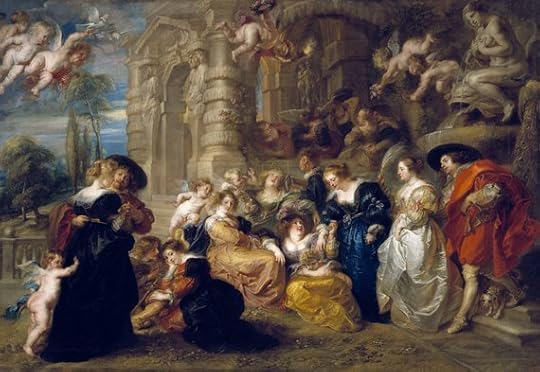
And then there is the absence of key works.
The Fall of the Damned is referenced heavily in the exhibition, and indeed there is one preparatory sketch for this awesome piece of work in the galleries. And the drawing is wonderful. A waterfall, a rushing flood, of tangled, heaving bodies tumble across the page. A terrifying scene of terrified faces trying to escape the eternal fire.
It's a stunning piece of work and it has evidently been a huge influence on Jan Boeckhorst and Pieter Claesz Soutman, whose own works hang nearby. Given the focus on the legacy of this seminal painting from Rubens, it's a shame the original wasn't released for inclusion in the show.
Certainly the overall impression is that the content of the exhibition has been spread very thin - making the most of what seems to be a very small pool of Rubens' works released for this show.
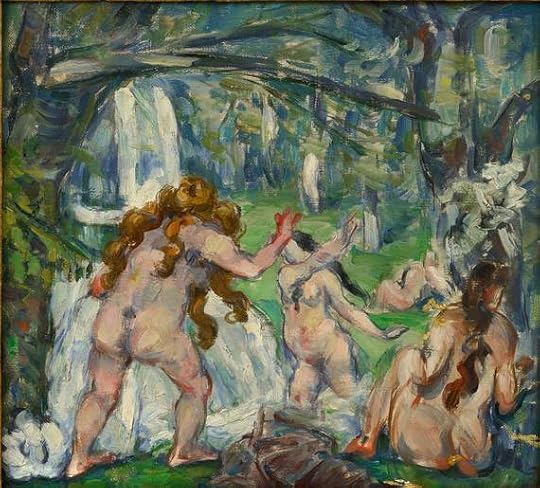
Which may explain the rather unexpected and surprising room of contemporary art curated by Jenny Saville that is included. Not a single Rubens in the room - instead work from Picasso to Cecily Brown, from Cy Twombly to Lucian Freud, have been brought together on the premise that they have been influenced by Rubens in some way.
Now, I loved this room. I thought it was bold and exciting. The question is, what does a De Kooning, some Picassos and an Andy Warhol have to do with Rubens? The answer, I feel, is not a lot.
The Andy Warhol of Jackie Kennedy is there, I think, as a representative of some modern Pieta, but Rubens didn't create the Pieta. Nor did he create the nude and few of the nudes in the room were particularly Rubenesque.
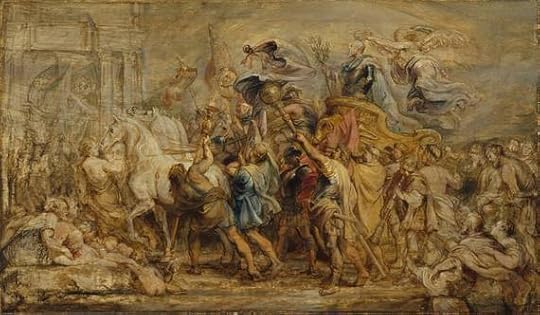
Rubens' nudes were fleshy, passive, idealised creatures with perfect shimmering complexions and pert breasts. That depiction is about as far away as you can get from Jenny Saville's and Lucien Freud's nudes so again, I wasn't really sure on the link - unless these were to be seen as deliberate rejections o this form of nude..
A notable exception was the stunning new work from Jenny Saville herself that is on show in the room. Two heads sit on top of a mass of intertwined thrusting bodies, a depiction that reminded me of Fall of the Damned, but that only in turn again emphasised the loss of not actually having that great Rubens painting on show.
And all of this leads me to my main conundrum.
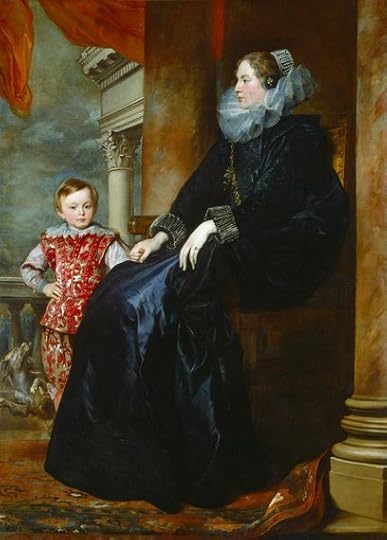
Did I actually enjoy the exhibition? Well yes, in as much as I would enjoy walking through the rooms of any major art gallery which has its walls covered with Cezannes, Picassos, Renoirs, Turners, Van Dycks, Constables, Freuds, a couple of Warhols and Bacons, and a few Rubens thrown in for good measure. But as a cohesive, coherent exhibition on Rubens, I'm not sure this exhibition made its point.
It's worth the price of admission just to see those few Rubens paintings on show. It's just a shame there weren't more of them.
Image Credits:
1. Peter Paul Rubens Tiger, Lion and Leopard Hunt, 1616 Oil on canvas, 256 x 324.5 cm Rennes, Musee des Beaux Arts Photo c. MBA, Rennes, Dist. RMN-Grand Palais / Adelaide Beaudoin
2. Peter Paul Rubens Pan and Syrinx, 1617 Oil on panel, 40 x 61 cm Museumslandschaft Hessen Kassel, Gemaeldegalerie Alte Meister, Kassel Photo: Museumslandschaft Hessen Kassel, Gemaeldegalerie Alte Meister/Ute Brunzel
3. Peter Paul Rubens The Garden of Love, c. 1633 Oil on canvas, 199 x 286 cm Museo Nacional del Prado. Madrid Photo c. Madrid, Museo Nacional del Prado
4. Paul Cezanne Three Bathers, c. 1875 Oil on canvas, 30.5 x 33 cm Private Collection Photo: Ali Elai, Camerarts
5. Peter Paul Rubens The Triumph of Henri IV, 1630 Oil on panel, 49.5 x 83.5 cm Lent by The Metropolitan Museum of Art, Rogers Fund, 1942 (42.187) Photo c. 2013. Image copyright The Metropolitan Museum of Art / Art Resource / Scala, Florence
6. Sir Anthony Van Dyck A Genoese Noblewoman and Her Son, c. 1626 Oil on canvas, 191.5 x 139.5 cm National Gallery of Art, Washington, Widener Collection, 1942.9.91 Photo Courtesy National Gallery of Art, Washington
Published on January 21, 2015 05:45
January 15, 2015
The Merchant of Venice Goes to Vegas at Almeida Theatre
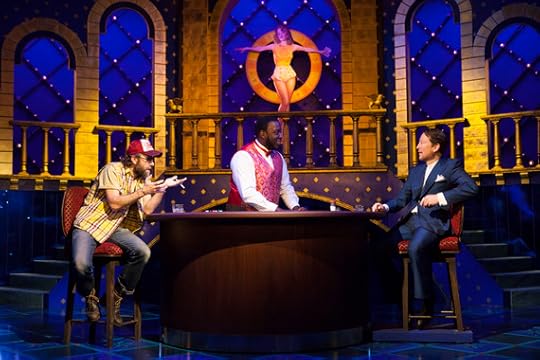
Shakespeare's classic tale becomes The Merchant of the Venetian as director Rupert Goold replaces the play's traditional setting of Venice with the casino floors and glitzy lights of Las Vegas, complete with Elvis impersonators, Vegas showgirls and even Cirque de Soleil-style gymnasts.
The bright lights of The Strip makes for a heady and pertinent setting in this version that brings to the fore the themes of greed, desire and alienation.
Ian McDiarmid plays the villainous Shylock with a lot of glee. Sometimes I find his performances a bit much but here he just about reins it in enough to allow us to sympathise with him as the grief at the loss of his daughter, Jessica (a lovely performance from Caroline Martin) quickly turns to anger, feeding thoughts of revenge. His Shylock is evil, yes, but also pitiable.
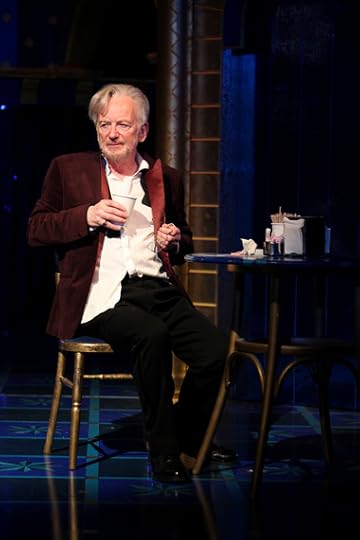
How any production of The Merchant of Venice handles the anti-Semitism in the text is always interesting. Rupert Goold has absolutely not shied away from it at all. The anti-Semitic abuse spat out at Shylock is practically palpable in its vehemence.
For me, that works well in this contemporary setting. The speed with which the other characters' hatred of Shylock is manifested in their racism is an uncomfortable reflection on racism in our society today, and one that we must examine.
But there are other themes brought out in this production too that fascinate.
Scott Handy impresses with his quite heartbreakingly tender portrayal of Antonio, the one who seals the bloody pact with Shylock, offering up a pound of his flesh so that his friend Bassanio has the money to woo the heiress, Portia.
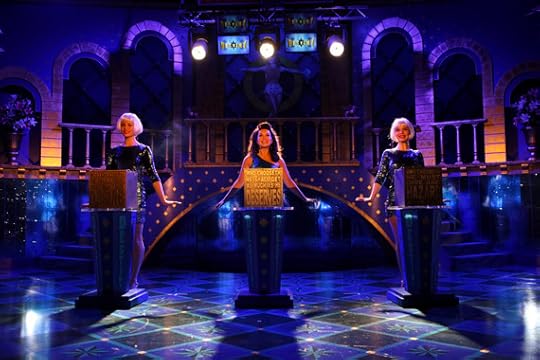
Rupert Goold's direction really exploits the ambiguity in the text, portraying Antonio as a man in love with Bassanio, a love that you sense is not reciprocated in the way that Antonio wants. And so Antonio's sacrifice for Bassanio hits home that little bit more when you sense that it was made for unrequited love.
This tragedy is offset beautifully by the comedy employed in Portia's handling of her many suitors. Here, Portia's love life has been reduced to a television show where contestants line up to unravel a puzzle in order to win her hand in marriage - and the money that comes with her.
Susannah Fielding's portrayal of Portia is terrific - funny but full of complexity for even here, the comedy has a dark, tragic undertone. Portia's powerlessness is evident and, like much in Vegas, the value of her soul is irrelevant in a world that values her only by her looks and her money.
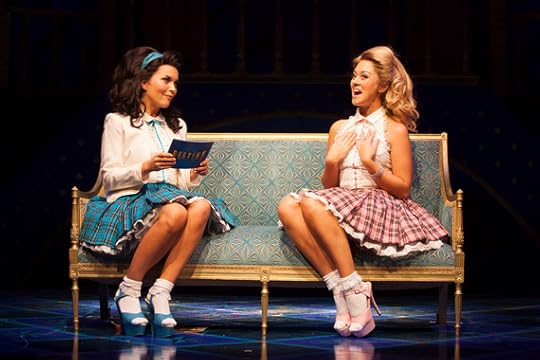
It's this dark side to Rupert Goold's production that fascinates. Even at the end, when all is supposedly remedied for the best, you sense a devastation and scars that will never heal across all the characters in the play. Like the city they're standing in, things only look good on the surface.
The design comes courtesy of Tom Scutt and it is both stunning and clever. There are all the slot machines and croupier tables that you'd expect but there's also a nice Rialto Bridge-style effect to the staircases down to the casino floor and the constant message of consumerist greed is pumped home with 24-hour shopping channel-style television shows running on silent on screens in the corners of the auditorium.
On the surface, transporting the play to Vegas seems a revolutionary approach. And it is. But in fact it's an inspired one that shows great reverence for the text and its themes. And like all great Shakespeare productions, this version at the Almeida is a terrific blend of drama, tragedy, comedy and music.
The Merchant of Venice, Almeida Theatre to February 14, 2015
Image Credits:
1. Tim Steed, Raphael Sowole and Scott Handy by Ellie Kurttz
2. Ian McDiarmid by Ellie Kurttz
3. Merry Holden, Emily Plumtree and Rebecca Brewer by Ellie Kurttz
4. Emily Plumtree and Susannah Fielding by Ellie Kurttz
Published on January 15, 2015 09:19
January 12, 2015
A Stunning Revival of Sondheim's Assassins at Menier Chocolate Factory
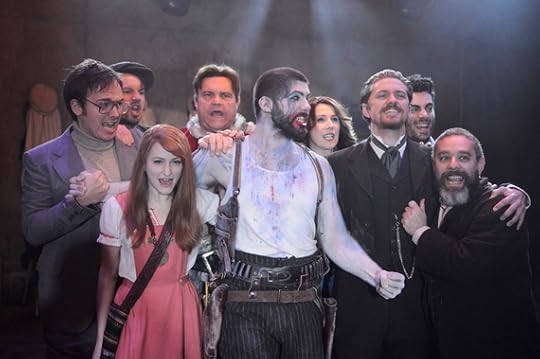
Wow, wow, wow! Assassins at Menier Chocolate Factory is absolutely stunning. With music and lyrics from Stephen Sondheim and a book from John Weidman, this is such a dark, riveting revival of a musical about those few who've tried to assassinate the President of the United States.
What connects these men and women? Why would someone pick up a gun and shoot to kill the President? These are questions that make this story such a fascinating examination of human motivations.
Yet this dark, clinical subject matter is contrasted with some terrific big-band numbers. Sondheim's score is at times ironically bright and provocative. Listening to a motley crew of would-be assassins from across the centuries singing "Everybody has a right to be happy, everybody has a right to their dreams" is quite startling, but gloriously so.
Jamie Lloyd is the man at the helm and his direction is dynamic. Any traditional stage has been stripped away and the auditorium at the Menier has been transformed into an abandoned and quite terrifyingly sinister fairground.
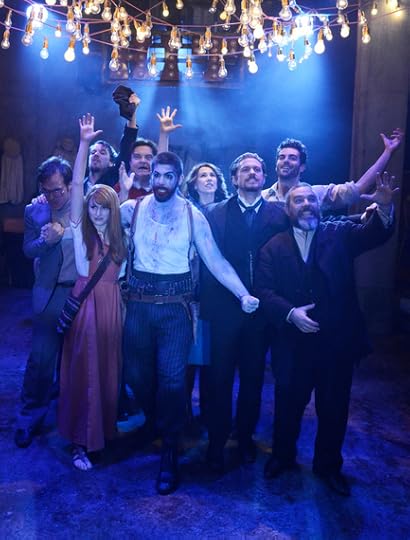
Soutra Gilmour collaborates with Jamie Lloyd again and her faded fairground set design is eerie and evocative. Large clown heads decapitated from their position above carousel rides lie fallen across the stage floor whilst above, fairground lights and illuminated signs flash up in the darkness.
The play starts off with the first of them all - John Wilkes Booth (Aaron Tveit) and his assassination of Lincoln. John weighs it up, he takes aim - and hits his mark. And from there, we are led through fascinating dramatizations and interrogations of motivations for each of the nine would-be murderers, ending with the most famous one of them all - Lee Harvey Oswald.
Remarkably, there is plenty of humour on show - Catherine Tate and Carly Bawden create a luscious pair as they scheme, rather ineffectively, to assassinate Ford, whilst Andy Nyman makes for a wonderfully eccentric and delusional Guiteau, the man who killed President Garfield. And Mike McShane is wonderful as Samuel Byck, the desperate man at the end of his rope trying to kill Nixon.
Yet this piece is shot through (no pun intended - or maybe it was) with some moments of real darkness. There was no happy ending for any of these assassins - whether they failed or succeeded - and the dramatized hangings and electrocutions are potent and dramatic.
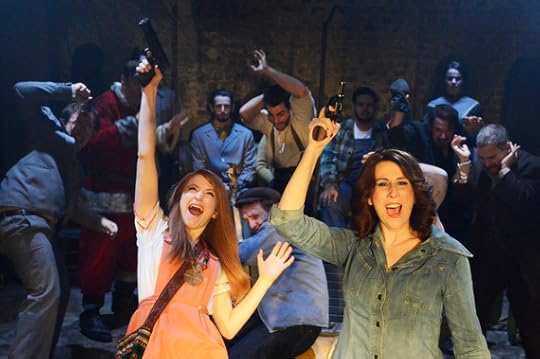
It is impossible to single out an individual actor in the cast for praise as all of them in this ensemble cast are superb, as is the live band. I don't normally like musicals but I just loved this.
Sondheim's music and lyrics are wonderful, and there's even a cheeky burst of Bernstein's "America" thrown in for good measure. Yet none of this comes at the expense of the book, of the story, which is fresh and fascinating. It's no surprise this musical won a heap of Tonys when it opened on Broadway - but this is a fine revival.
Sadly I think there are only day seats and returns left for this remarkable show. Such a shame as I would have desperately loved to have seen this again. Maybe, if we're lucky, a West End transfer beckons as this show just dazzles with its exciting and heady mix of darkness and light. Wonderful.
Menier Chocolate Factory, London to March 7, 2015
Image Credits:
All images are by Nobby Clark.
1. Harry Morrison (John Hinckley) David Roberts (Leon Czolgosz) Carly Bawden (Lynette 'Squeaky' Fromme) Mike McShane (Samuel Byck) Simon Lipkin (Proprietor) Catherine Tate (Sara Jane Moore) Aaron Tveit (John Wilkes Booth) Stewart Clarke (Giuseppe Zangara) Andy Nyman (Charles Guiteau)
2. Background: Harry Morrison (John Hinckley), David Roberts (Leon Czolgosz), Mike McShane (Samuel Byck), Catherine Tate (Sara Jane Moore), Stewart Clarke (Giuseppe Zangara). Foreground: Carly Bawden (Lynette 'Squeaky' Fromme), Simon Lipkin (Proprietor), Aaron Tveit (John Wilkes Booth), Andy Nyman (Charles Guiteau)
3. Carly Bawden (Lynette 'Squeaky' Fromme), Catherine Tate (Sara Jane Moore) by Nobby Clark
Published on January 12, 2015 01:53
January 6, 2015
Fashion, Photography, Science, and Coral Reefs... Top 10 London Exhibitions for 2015
Fashion, food, photography, wildlife, science and even curiosities. There is an extraordinary diversity of subjects in this top 10 list of London exhibitions for 2015. Mark these in your calendar and your brain will be like a sponge, just soaking it all up.
1. Alexander McQueen: Savage Beauty, Victoria & Albert Museum
(March 14 - July 19, 2015)
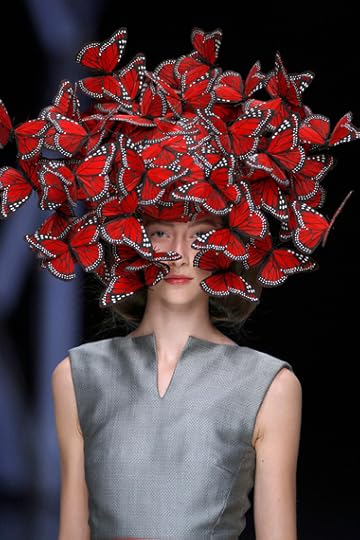
This retrospective on the work of the extraordinarily talented Alexander McQueen promises to be the stand-out fashion exhibition of the year. This exhibition wowed audiences when it opened in New York at the city's Metropolitan Museum of Art in 2011. The displays will span the breadth of McQueen's brilliant, though tragically short, career from his 1992 MA graduate collection to his unfinished A/W 2010 collection.
2. Magnificent Obsessions: The Artist as Collector, Barbican Centre
(February 12 - May 25, 2015)
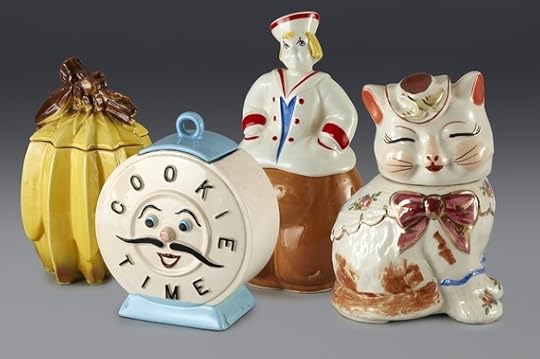
This exhibition has an extraordinary premise - to examine a number of post-war and contemporary artists through their own personal collections. Ranging from mass-produced memorabilia and popular collectibles, to unique curiosities and rare specimens, these collections hopefully will give us an insight into the inspirations, influences and interests of artists including Damien Hirst, Peter Blake and Andy Warhol.
3. Human Rights Human Wrongs, The Photographer's Gallery
(February 6 - April 6, 2015)
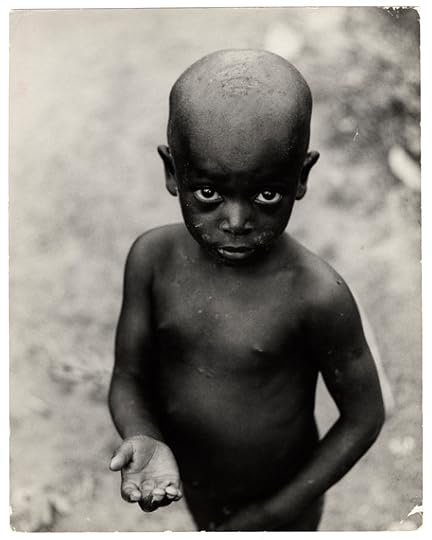
Photography can create powerful images, and photojournalism can etch emotive scenes in our heads - but what is the legacy of these images? That is the fascinating question posed by this photography exhibition that will bring together 300 original prints from the prestigious Black Star Collection to consider whether images of political struggle and suffering can work both for and against victims in terms of representation and portrayal. A really big question and one that fascinates me.
4. Audrey Hepburn: Portraits of an Icon, National Portrait Gallery
(July 2 - October 18, 2015)
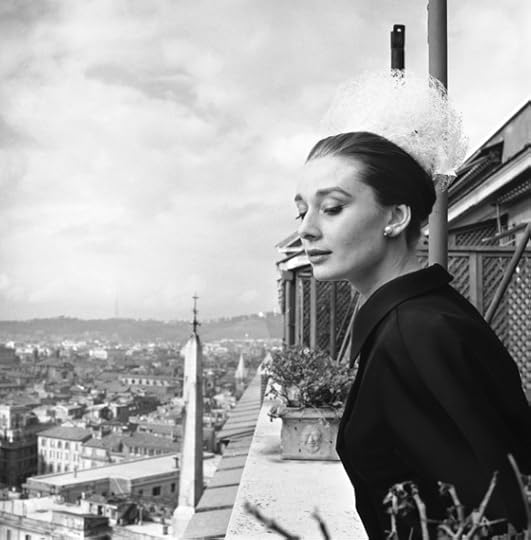
People still adore Audrey Hepburn so this photography exhibition, I've no doubt, will be incredibly popular. The National Portrait Gallery is bringing together classic portraits of the star by legends such as Richard Avedon, Cecil Beaton and Norman Parkinson with rarely seen private photographs. The display will follow Hepburn's rise to fame, from her early years in Holland and as a dancer in London's West End, to her becoming a stage and screen icon, culminating in her philanthropic work in later life.
5. Churchill's Scientists, Science Museum
(Opens January 23, 2015)
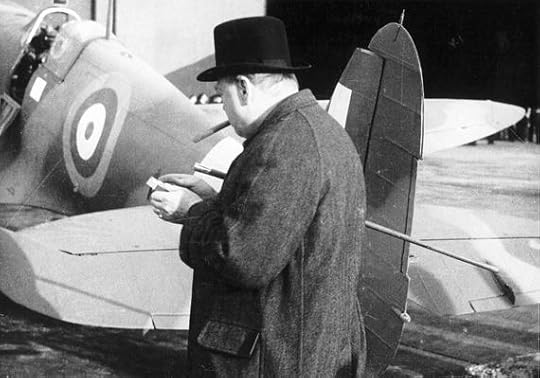
This exhibition is timed to coincide with the 50th anniversary of Churchill's death and will examine Churchill's enduring fascination with science and shine a light on those huge breakthroughs that were made during his time, such as Robert Watson-Watt's invention of the radar, which helped Britain win against the odds in the Battle of Britain, and Dorothy Hodgkin's advancement of X-ray crystallography. With such recent successes as Collider, Alan Turing and mental illness, the Science Museum has really established itself as a place for terrific exhibitions so I'm looking forward to this.
6. Shoes: Pleasure and Pain, Victoria & Albert Museum
(June 13, 2015 - January 31, 2016)
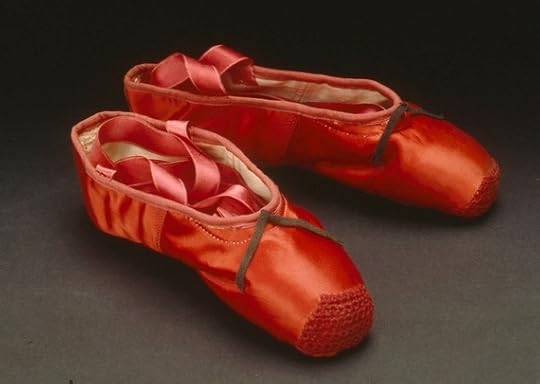
The title says it all! Our love affair with shoes and their transformative effect will be examined in this fascinating exhibition at the V&A which will display shoes from across the world and the centuries, from a sandal decorated in pure gold leaf from ancient Egypt to futuristic looking shoes using 3D printing. More than 200 pairs of shoes will be on display and it will be fascinating to extrapolate out from these what they say about us. Above is one of the thrilling exhibits - the deadly red ballet shoes from The Red Shoes.
7. Cravings: Can Your Food Control You?, Science Museum
(Opens February 12, 2015)
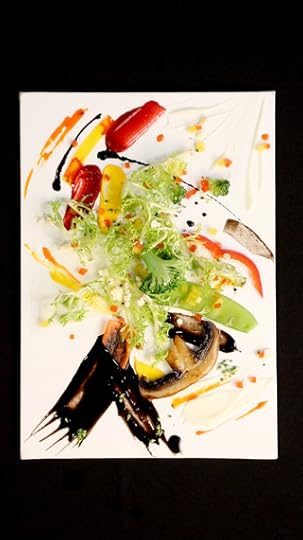
Now this is an exhibition I am desperate to see. Do I love food or do I crave it? And if it's the latter, what is causing that? This free exhibition at the Science Museum will explore how food affects our body, brain and eating habits through personal stories, fascinating objects and cutting-edge science and technology. And by revealing how not one but two brains work together alongside the hidden world of gut bacteria to affect our cravings, we'll be left to consider how our food can control us.
8. Coral Reefs: Secret Cities of the Seas, Natural History Museum
(Opens March 27, 2015)

I was incredibly moved by the Wildlife Photographer of the Year 2014 exhibition at the Natural History Museum, a powerful demonstration on the fragile beauty of nature, and I'm expecting this to have the same impact. Coral reefs are home to almost a quarter of all living species under the sea and this display will demonstrate why reefs are so important and how their future is being secured. Highlights of the exhibition will include beautiful corals from the Museum's vast collection, spectacular underwater photography and an aquarium with live sea coral and fish.
9. Salt and Silver: Early Photography 1840-1860, Tate Britain
(February 25 - June 7, 2015)
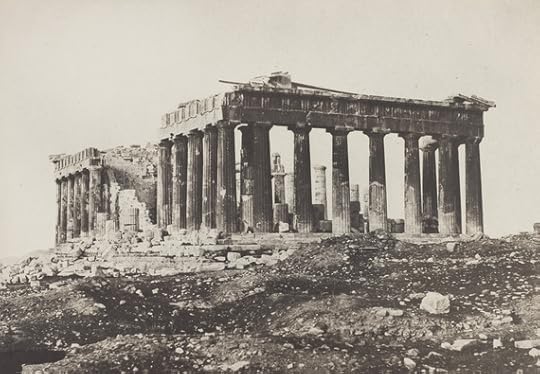
Salted paper prints were one of the earliest forms of photography. This process was a British invention but this was such a revolutionary technique that it soon spread around the world. The effect of this process gave the images a romantic soft focus. But sadly few of these prints remain and those we still have are seldom seen because of their fragility. This exhibition at Tate Britain will therefore be a rare opportunity to see these photographs.
10. The Fabric of India, Victoria and Albert Museum
October 3, 2015 - January 10, 2016
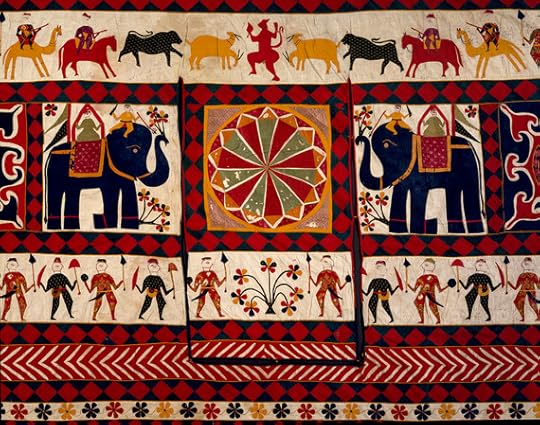
This will be the first major exhibition to explore the dynamic and multifaceted world of handmade textiles from India. It will showcase the best of the V&A's world-renowned collection together with masterpieces from overseas. The scope of the exhibition is vast, reflecting India's extraordinary heritage, and will include objects from the 3rd to the 21st century, encompassing renowned masterworks and the very latest in Indian contemporary design.
Image Credits:
1. Butterfly headdress of hand-painted turkey feathers, Philip Treacy for Alexander McQueen, La Dame Bleue S/S 2008, Model: Alana Zimmer © Anthea Simms
2. Andy Warhol, Cookie jars previously owned by Andy Warhol (1928-87). Image courtesy of Movado Group
3. Carlo Bavagnoli, Biafra, Republic of Biafra (now the Federal Republic of Nigeria), ca. 1968 Gelatin silver print, BS.2005.059951/37-1079 The Black Star Collection, Ryerson Image Centre
4. Audrey Hepburn in Rome by Cecil Beaton, 1960, copyright: The Cecil Beaton Studio Archive at Sothebys
5. Churchill with a spitfire from Castle Bromwich credit Philip Insley CBAF Archive Vickers ArchivesSyndics
6. Red ballet shoes made for Victoria Page (Moira Shearer) in The Red Shoes (1948), silk satin, braid and leather, England, Freed of London (founded in 1929), Date: 1948, Photograph reproduced with the kind permission of Northampton Museums and Art Gallery
7. Salad with a Taste of Kandinsky, credit Bottletop / Science Museum
8. Christmas tree worm Catlin Seaview Survey
9. Eugene Piot, The Parthenon from the Acropolis, Athens c1848 © Wilson Centre for Photography
10. Wall hanging (detail), 20th century, Victoria and Albert Museum, London
1. Alexander McQueen: Savage Beauty, Victoria & Albert Museum
(March 14 - July 19, 2015)

This retrospective on the work of the extraordinarily talented Alexander McQueen promises to be the stand-out fashion exhibition of the year. This exhibition wowed audiences when it opened in New York at the city's Metropolitan Museum of Art in 2011. The displays will span the breadth of McQueen's brilliant, though tragically short, career from his 1992 MA graduate collection to his unfinished A/W 2010 collection.
2. Magnificent Obsessions: The Artist as Collector, Barbican Centre
(February 12 - May 25, 2015)

This exhibition has an extraordinary premise - to examine a number of post-war and contemporary artists through their own personal collections. Ranging from mass-produced memorabilia and popular collectibles, to unique curiosities and rare specimens, these collections hopefully will give us an insight into the inspirations, influences and interests of artists including Damien Hirst, Peter Blake and Andy Warhol.
3. Human Rights Human Wrongs, The Photographer's Gallery
(February 6 - April 6, 2015)

Photography can create powerful images, and photojournalism can etch emotive scenes in our heads - but what is the legacy of these images? That is the fascinating question posed by this photography exhibition that will bring together 300 original prints from the prestigious Black Star Collection to consider whether images of political struggle and suffering can work both for and against victims in terms of representation and portrayal. A really big question and one that fascinates me.
4. Audrey Hepburn: Portraits of an Icon, National Portrait Gallery
(July 2 - October 18, 2015)

People still adore Audrey Hepburn so this photography exhibition, I've no doubt, will be incredibly popular. The National Portrait Gallery is bringing together classic portraits of the star by legends such as Richard Avedon, Cecil Beaton and Norman Parkinson with rarely seen private photographs. The display will follow Hepburn's rise to fame, from her early years in Holland and as a dancer in London's West End, to her becoming a stage and screen icon, culminating in her philanthropic work in later life.
5. Churchill's Scientists, Science Museum
(Opens January 23, 2015)

This exhibition is timed to coincide with the 50th anniversary of Churchill's death and will examine Churchill's enduring fascination with science and shine a light on those huge breakthroughs that were made during his time, such as Robert Watson-Watt's invention of the radar, which helped Britain win against the odds in the Battle of Britain, and Dorothy Hodgkin's advancement of X-ray crystallography. With such recent successes as Collider, Alan Turing and mental illness, the Science Museum has really established itself as a place for terrific exhibitions so I'm looking forward to this.
6. Shoes: Pleasure and Pain, Victoria & Albert Museum
(June 13, 2015 - January 31, 2016)

The title says it all! Our love affair with shoes and their transformative effect will be examined in this fascinating exhibition at the V&A which will display shoes from across the world and the centuries, from a sandal decorated in pure gold leaf from ancient Egypt to futuristic looking shoes using 3D printing. More than 200 pairs of shoes will be on display and it will be fascinating to extrapolate out from these what they say about us. Above is one of the thrilling exhibits - the deadly red ballet shoes from The Red Shoes.
7. Cravings: Can Your Food Control You?, Science Museum
(Opens February 12, 2015)

Now this is an exhibition I am desperate to see. Do I love food or do I crave it? And if it's the latter, what is causing that? This free exhibition at the Science Museum will explore how food affects our body, brain and eating habits through personal stories, fascinating objects and cutting-edge science and technology. And by revealing how not one but two brains work together alongside the hidden world of gut bacteria to affect our cravings, we'll be left to consider how our food can control us.
8. Coral Reefs: Secret Cities of the Seas, Natural History Museum
(Opens March 27, 2015)

I was incredibly moved by the Wildlife Photographer of the Year 2014 exhibition at the Natural History Museum, a powerful demonstration on the fragile beauty of nature, and I'm expecting this to have the same impact. Coral reefs are home to almost a quarter of all living species under the sea and this display will demonstrate why reefs are so important and how their future is being secured. Highlights of the exhibition will include beautiful corals from the Museum's vast collection, spectacular underwater photography and an aquarium with live sea coral and fish.
9. Salt and Silver: Early Photography 1840-1860, Tate Britain
(February 25 - June 7, 2015)

Salted paper prints were one of the earliest forms of photography. This process was a British invention but this was such a revolutionary technique that it soon spread around the world. The effect of this process gave the images a romantic soft focus. But sadly few of these prints remain and those we still have are seldom seen because of their fragility. This exhibition at Tate Britain will therefore be a rare opportunity to see these photographs.
10. The Fabric of India, Victoria and Albert Museum
October 3, 2015 - January 10, 2016

This will be the first major exhibition to explore the dynamic and multifaceted world of handmade textiles from India. It will showcase the best of the V&A's world-renowned collection together with masterpieces from overseas. The scope of the exhibition is vast, reflecting India's extraordinary heritage, and will include objects from the 3rd to the 21st century, encompassing renowned masterworks and the very latest in Indian contemporary design.
Image Credits:
1. Butterfly headdress of hand-painted turkey feathers, Philip Treacy for Alexander McQueen, La Dame Bleue S/S 2008, Model: Alana Zimmer © Anthea Simms
2. Andy Warhol, Cookie jars previously owned by Andy Warhol (1928-87). Image courtesy of Movado Group
3. Carlo Bavagnoli, Biafra, Republic of Biafra (now the Federal Republic of Nigeria), ca. 1968 Gelatin silver print, BS.2005.059951/37-1079 The Black Star Collection, Ryerson Image Centre
4. Audrey Hepburn in Rome by Cecil Beaton, 1960, copyright: The Cecil Beaton Studio Archive at Sothebys
5. Churchill with a spitfire from Castle Bromwich credit Philip Insley CBAF Archive Vickers ArchivesSyndics
6. Red ballet shoes made for Victoria Page (Moira Shearer) in The Red Shoes (1948), silk satin, braid and leather, England, Freed of London (founded in 1929), Date: 1948, Photograph reproduced with the kind permission of Northampton Museums and Art Gallery
7. Salad with a Taste of Kandinsky, credit Bottletop / Science Museum
8. Christmas tree worm Catlin Seaview Survey
9. Eugene Piot, The Parthenon from the Acropolis, Athens c1848 © Wilson Centre for Photography
10. Wall hanging (detail), 20th century, Victoria and Albert Museum, London
Published on January 06, 2015 16:00
January 2, 2015
Top 10 London Art Exhibitions to See in 2015
2014 saw some exciting blockbuster exhibitions including Matisse and Rembrandt, and these were included in my top 10 list for the year, alongside some thrilling unexpected finds such as Moroni, South American art and contemporary artists on the human body.
It was a great year for art shows in the capital but, frustratingly, the big exhibitions were dominated by white male artists. So it is with great delight that the calendar for 2015 sees this challenged in a big way. Here is my list of those art exhibitions in London to put in your diary for 2015.
1. Barbara Hepworth, Tate Britain
(June 24 - October 25, 2015)
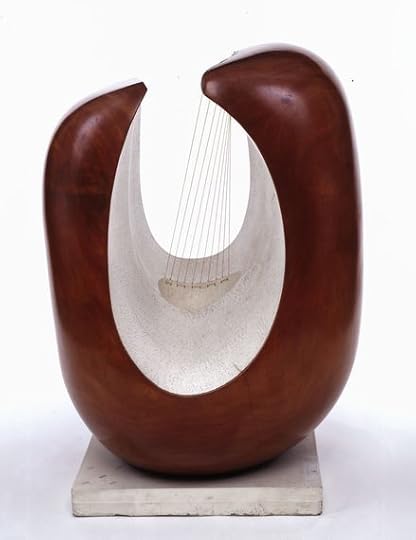
I adore Barbara Hepworth's sculptures and her reputation as one of the leading figures in the post-war art world is well-deserved. This exhibition at Tate Britain of her extraordinary work will be the first in London for over 50 years and will chart her progress from small carvings to her magnificent wood, stone and bronze sculptures. Exhibits will also include rarely seen works including textiles, drawings, collages and phonograms.
2. Ai Weiwei, Royal Academy of Arts
(September 19 - December 13, 2015)
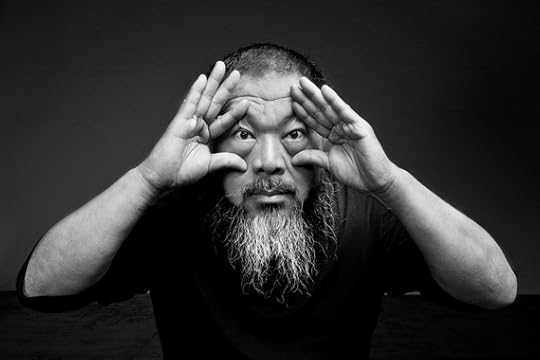
It's impossible to say whether Ai Weiwei will be allowed to leave China to work on this, the first retrospective of his work, at the Royal Academy. In the wider public, this artist's struggles with the Chinese government are probably more well known than the details of his work. Hopefully therefore many will visit the RA to see the man's art for themselves as he is a real visionary.
3. Marlene Dumas, Tate Modern
(February 5 - May 10, 2015)
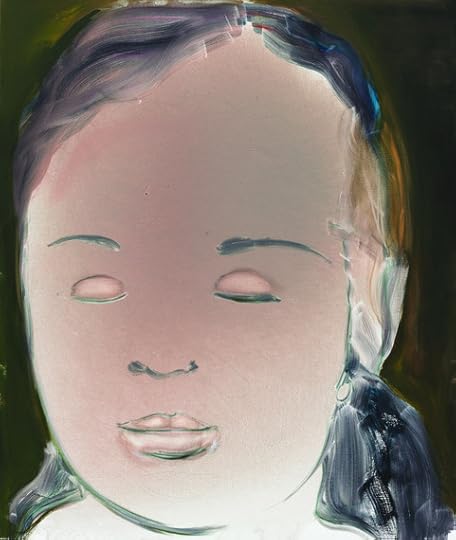
Marlene Dumas is a hugely exciting artist, one of the most prominent painters of her generation. This exhibition at the Tate will be the most significant display of her work ever to be held in Europe. Expect plenty of her signature work that examines such profound themes as life and death, gender and sexuality, and the influence of mass media and celebrity.
4. Sonia Delaunay, Tate Modern
(April 15 - August 9, 2015)
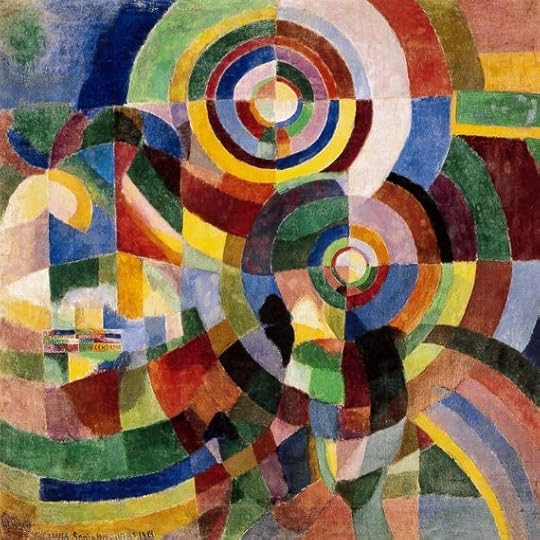
This exhibition at the Tate Modern will be the first ever retrospective in the UK on this key figure in the Parisian avant-garde.
Sonia Delaunay celebrated the modern world of movement, technology and urban life and this show will feature much of her colourful output from across a wide range of media including paintings, textiles and clothes, as well as her innovative collaborations with poets, choreographers and manufacturers.
5. Rubens and His Legacy, Royal Academy of Arts
(January 24 - April 10, 2015)
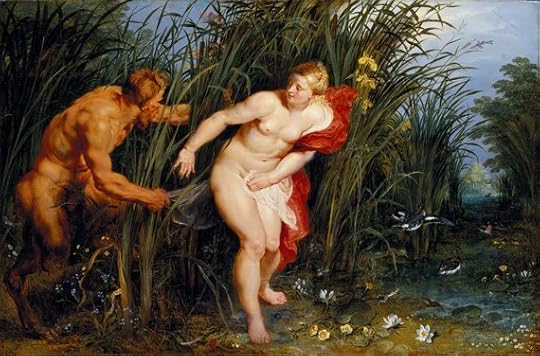
One of the real pleasures of the art shows in 2014 was having my understanding on familiar names enriched by some superb exhibitions, such as those on Turner, Constable, Malevich and Rembrandt. I'm hoping for a similar impact with this show on Rubens, 'the prince of painters', at the RA.
Rubens and His Legacy will bring together masterpieces produced during his lifetime, as well as major works by great artists who were influenced by him such as Picasso, Rembrandt, Van Dyck, Delacroix, Constable and Gainsborough.
6. History is Now, Hayward Gallery
(February 10 - April 26, 2015)
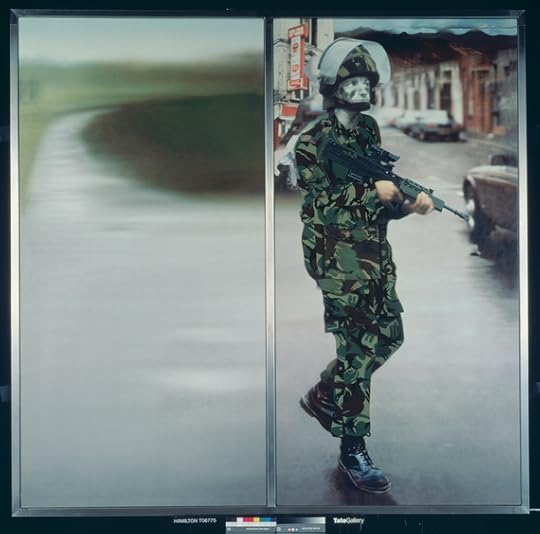
This exciting exhibition is tied in to the 2015 General Election and will see seven contemporary artists give their unique take on the cultural history of the United Kingdom.
Each will curate a separate part of the exhibition, looking at particular periods of our cultural history from the post-war period to the present day and will include subjects such as the Cold War, Thatcherism, feminism, protest movements and even BSE.
7. The World Went Pop, Tate Modern
(September 17, 2015 - January 24, 2016)
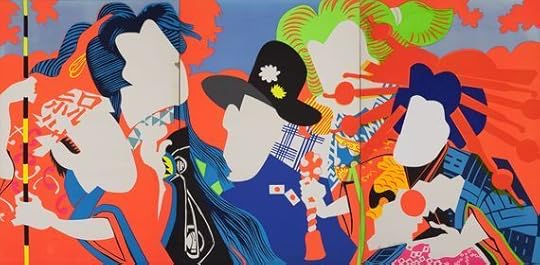
Most of us know Pop Art as a commentary on Western consumerism but this explosive new exhibition (see what I did there?) will reveal how artists around the world engaged with this dynamic art style, from Latin America to Asia, from the Middle East to Europe.
This show promises to demonstrate how different cultures contributed, rethought and responded to the movement. Many of the 200 works being collated together for this show will be on display in the UK for the first time.
8. Sargent: Portraits of Artists and Friends, National Portrait Gallery
(February 12 - May 25, 2015)
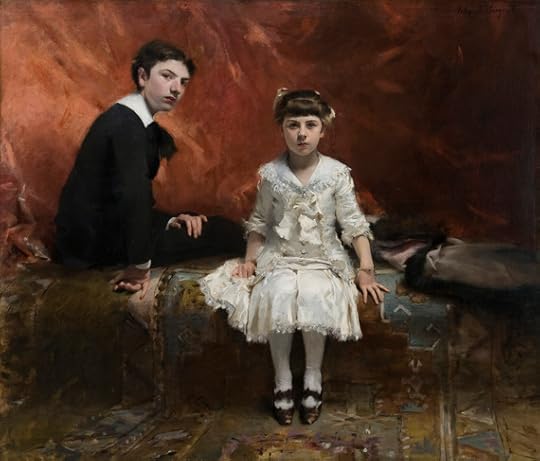
John Singer Sargent was widely considered to be the greatest portrait painter of his generation yet, like many artists, his commissioned work was also restrained by the wants of his customers. Not so in his non-commissioned work.
This show will bring together over 70 portraits Sargent made of his friends and family, including such contemporaries as Auguste Rodin and Claude Monet, where he had no such constraints and where he could create intimate and more experimental works.
9. Goya: The Portraits, National Gallery
(October 7, 2015 - January 10, 2016)
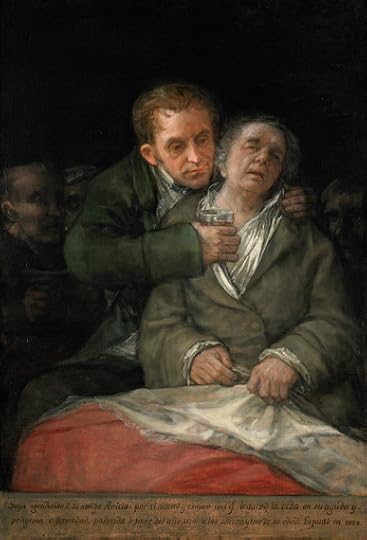
Goya is one of Spain's most celebrated artists yet this exhibition will be the first to focus solely on the great man's portraits. He was considered a supremely gifted portrait painter and an excellent social commentator who took the genre of portraiture to new heights through his ability to reveal the psychology of his sitter. The National Gallery is bringing together over 50 of Goya's portraits from across the length of his career. Expect this to be impressive!
10. Inventing Impressionism, National Gallery
(March 4 - May 31, 2015)
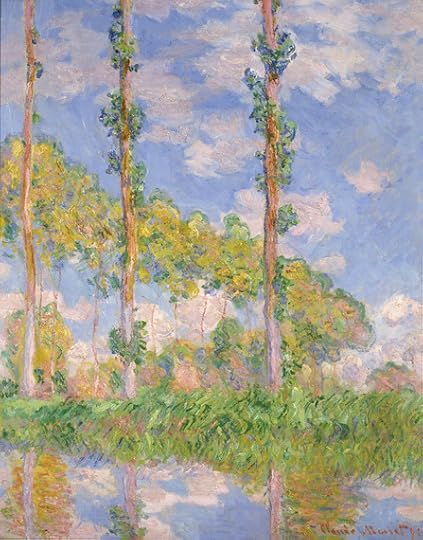
Of all the great names associated with Impressionism, Paul Durand-Ruel isn't one of them yet this entrepreneurial art dealer was a pivotal figure. He discovered artists such as Monet, Pissarro, Degas and Renoir and bought up hundreds, even thousands, of works by them when they were still largely ignored or ridiculed.
He was loyal to these artists, often backing then financially, and worked tirelessly and with innovation to turn them into respected names. This exhibition on Durand-Ruel will include around 85 works, among them a number of Impressionism's greatest masterpieces which have never been seen in the UK before.
Image Credits:
1. Barbara Hepworth, Curved Form (Delphi) 1955 ©The Estate of Dame Barbara Hepworth 2. Portrait of Ai Weiwei c. Gao Yuan
3. Marlene Dumas, Helena's Dream 2008 Kunsthalle Bielefeld © Marlene Dumas Photo: Peter Cox
4. Sonia Delaunay, Prismes electriques 1914 © Pracusa 2013057 © CNAP
5. Peter Paul Rubens Pan and Syrinx, 1617 Oil on panel, 40 x 61 cm Museumslandschaft Hessen Kassel, Gemaeldegalerie Alte Meister, Kassel Photo: Museumslandschaft Hessen Kassel, Gemaeldegalerie Alte Meister/Ute Brunzel
6. Richard Hamilton, The State,1993. © Tate, London 2014, DACS 2014
7. Ushio Shinohara, Doll Festival 1966 Photo courtesy of Tokyo Gallery+BTAP
8. Édouard and Marie-Louise Pailleron by John Singer Sargent, 1881 Copyright: Des Moines Art Center, Des Moines, Iowa
9. Goya Self Portrait with Doctor Arrieta, 1820 Oil on canvas 114.6 × 76.5 cm © The Minneapolis Institute of Arts, Minnesota, The Ethel Morrison Van Derlip Fund
10. Claude Monet Poplars in the Sun, 1891 Oil on canvas 93 × 73.5 cm The National Museum of Western Art, Matsukata Collection, Tokyo P.1959-0152 © National Museum of Western Art, Tokyo
It was a great year for art shows in the capital but, frustratingly, the big exhibitions were dominated by white male artists. So it is with great delight that the calendar for 2015 sees this challenged in a big way. Here is my list of those art exhibitions in London to put in your diary for 2015.
1. Barbara Hepworth, Tate Britain
(June 24 - October 25, 2015)

I adore Barbara Hepworth's sculptures and her reputation as one of the leading figures in the post-war art world is well-deserved. This exhibition at Tate Britain of her extraordinary work will be the first in London for over 50 years and will chart her progress from small carvings to her magnificent wood, stone and bronze sculptures. Exhibits will also include rarely seen works including textiles, drawings, collages and phonograms.
2. Ai Weiwei, Royal Academy of Arts
(September 19 - December 13, 2015)

It's impossible to say whether Ai Weiwei will be allowed to leave China to work on this, the first retrospective of his work, at the Royal Academy. In the wider public, this artist's struggles with the Chinese government are probably more well known than the details of his work. Hopefully therefore many will visit the RA to see the man's art for themselves as he is a real visionary.
3. Marlene Dumas, Tate Modern
(February 5 - May 10, 2015)

Marlene Dumas is a hugely exciting artist, one of the most prominent painters of her generation. This exhibition at the Tate will be the most significant display of her work ever to be held in Europe. Expect plenty of her signature work that examines such profound themes as life and death, gender and sexuality, and the influence of mass media and celebrity.
4. Sonia Delaunay, Tate Modern
(April 15 - August 9, 2015)

This exhibition at the Tate Modern will be the first ever retrospective in the UK on this key figure in the Parisian avant-garde.
Sonia Delaunay celebrated the modern world of movement, technology and urban life and this show will feature much of her colourful output from across a wide range of media including paintings, textiles and clothes, as well as her innovative collaborations with poets, choreographers and manufacturers.
5. Rubens and His Legacy, Royal Academy of Arts
(January 24 - April 10, 2015)

One of the real pleasures of the art shows in 2014 was having my understanding on familiar names enriched by some superb exhibitions, such as those on Turner, Constable, Malevich and Rembrandt. I'm hoping for a similar impact with this show on Rubens, 'the prince of painters', at the RA.
Rubens and His Legacy will bring together masterpieces produced during his lifetime, as well as major works by great artists who were influenced by him such as Picasso, Rembrandt, Van Dyck, Delacroix, Constable and Gainsborough.
6. History is Now, Hayward Gallery
(February 10 - April 26, 2015)

This exciting exhibition is tied in to the 2015 General Election and will see seven contemporary artists give their unique take on the cultural history of the United Kingdom.
Each will curate a separate part of the exhibition, looking at particular periods of our cultural history from the post-war period to the present day and will include subjects such as the Cold War, Thatcherism, feminism, protest movements and even BSE.
7. The World Went Pop, Tate Modern
(September 17, 2015 - January 24, 2016)

Most of us know Pop Art as a commentary on Western consumerism but this explosive new exhibition (see what I did there?) will reveal how artists around the world engaged with this dynamic art style, from Latin America to Asia, from the Middle East to Europe.
This show promises to demonstrate how different cultures contributed, rethought and responded to the movement. Many of the 200 works being collated together for this show will be on display in the UK for the first time.
8. Sargent: Portraits of Artists and Friends, National Portrait Gallery
(February 12 - May 25, 2015)

John Singer Sargent was widely considered to be the greatest portrait painter of his generation yet, like many artists, his commissioned work was also restrained by the wants of his customers. Not so in his non-commissioned work.
This show will bring together over 70 portraits Sargent made of his friends and family, including such contemporaries as Auguste Rodin and Claude Monet, where he had no such constraints and where he could create intimate and more experimental works.
9. Goya: The Portraits, National Gallery
(October 7, 2015 - January 10, 2016)

Goya is one of Spain's most celebrated artists yet this exhibition will be the first to focus solely on the great man's portraits. He was considered a supremely gifted portrait painter and an excellent social commentator who took the genre of portraiture to new heights through his ability to reveal the psychology of his sitter. The National Gallery is bringing together over 50 of Goya's portraits from across the length of his career. Expect this to be impressive!
10. Inventing Impressionism, National Gallery
(March 4 - May 31, 2015)

Of all the great names associated with Impressionism, Paul Durand-Ruel isn't one of them yet this entrepreneurial art dealer was a pivotal figure. He discovered artists such as Monet, Pissarro, Degas and Renoir and bought up hundreds, even thousands, of works by them when they were still largely ignored or ridiculed.
He was loyal to these artists, often backing then financially, and worked tirelessly and with innovation to turn them into respected names. This exhibition on Durand-Ruel will include around 85 works, among them a number of Impressionism's greatest masterpieces which have never been seen in the UK before.
Image Credits:
1. Barbara Hepworth, Curved Form (Delphi) 1955 ©The Estate of Dame Barbara Hepworth 2. Portrait of Ai Weiwei c. Gao Yuan
3. Marlene Dumas, Helena's Dream 2008 Kunsthalle Bielefeld © Marlene Dumas Photo: Peter Cox
4. Sonia Delaunay, Prismes electriques 1914 © Pracusa 2013057 © CNAP
5. Peter Paul Rubens Pan and Syrinx, 1617 Oil on panel, 40 x 61 cm Museumslandschaft Hessen Kassel, Gemaeldegalerie Alte Meister, Kassel Photo: Museumslandschaft Hessen Kassel, Gemaeldegalerie Alte Meister/Ute Brunzel
6. Richard Hamilton, The State,1993. © Tate, London 2014, DACS 2014
7. Ushio Shinohara, Doll Festival 1966 Photo courtesy of Tokyo Gallery+BTAP
8. Édouard and Marie-Louise Pailleron by John Singer Sargent, 1881 Copyright: Des Moines Art Center, Des Moines, Iowa
9. Goya Self Portrait with Doctor Arrieta, 1820 Oil on canvas 114.6 × 76.5 cm © The Minneapolis Institute of Arts, Minnesota, The Ethel Morrison Van Derlip Fund
10. Claude Monet Poplars in the Sun, 1891 Oil on canvas 93 × 73.5 cm The National Museum of Western Art, Matsukata Collection, Tokyo P.1959-0152 © National Museum of Western Art, Tokyo
Published on January 02, 2015 16:00
December 29, 2014
Impoverished Housing in Focus in Photography Exhibition at Science Museum
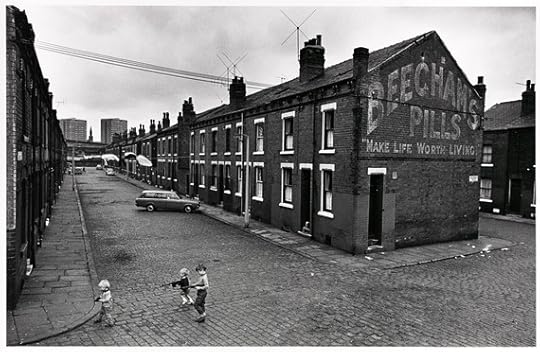
Make Life Worth Living is a collection of photographs at the Science Museum taken by Nick Hedges between 1968 and 1972 of the impoverished urban housing conditions that many Britons lived in.
The project was initially commissioned by the housing charity SHELTER, who wanted to document the living conditions in poor quality housing across the UK in a bid to raise awareness about the extent of the squalor and poverty that many lived in, and the profound human cost of that existence.
Exhibited for the first time, following a 40 year restriction to protect the anonymity of the subjects, one hundred black and white photographs are displayed alongside edited texts from Hedges' detailed written notes of his travels and encounters.
As you can imagine, most of these photos are quite harrowing. The grim housing blocks, the damp, squalid rooms, the complete absence of heat, light and many other things most of us take for granted is depressing and incredibly humbling.
Yet there is no sentimentality in these images. Some of them reflect moments of bonding, love and happiness despite the conditions. Whilst in others, the impact of trying to just survive in impossible conditions is etched across the faces.
As Nick Hedges commented, "The thing about people living in slum housing is that there is no drama... It's about the absolute wearing down of people's morale in a quiet and undemonstrative way."
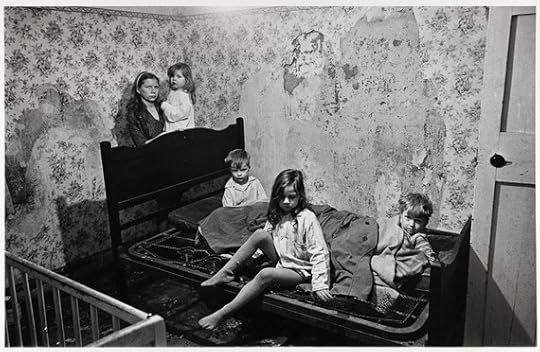
And this is a key point, that it's not just that people lived like this, which is bad enough, but the knock on effects this had on every part of their life, and the lives of those who depended on them. Our opportunities in life are limited by our circumstance. And the worse the circumstance, the worse the opportunities.
Nick Hedges visited many cities in this four year project including Liverpool, London, Glasgow, Birmingham and Manchester. The sad truth is that, with the odd exception of a steel factory in the background or a Welsh valley, there's little in these photos to distinguish one city from another - they're all the same.
And this has been communicated really well in the curation of this display. The temptation could have been to group the photos by location but instead the photos are intermingled - a shot from Toxteth 1969 is shown alongside one from Vauxhall 1970, which is next to a photo from Bradford 1969.
The effect is profound and reinforces the message that all cities were the same and that each hid a dark underbelly.
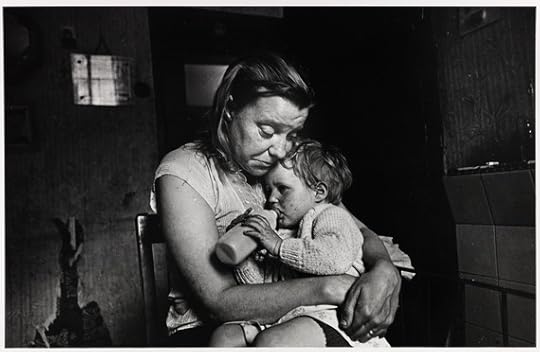
The addition of Nick Hedges' notes brings real depth and added context to the shots, such as an explanation for the skin infection covering a young girl's face in one photo - an infection caused by sewage seeping above ground into the courtyard outside her home. Or the single mother of six who took sleeping pills every night to shut herself off from the squalor of living with no gas, electricity or hot water.
One of the fears I had on my way to this exhibition was that this display might be a rather sorrowful reflection on our recent past but with little to say about our present. However that fear proved to be, sadly, misplaced.
As SHELTER emphasise in the exhibition, today, every 11 minutes a family in Britain loses their home. That's frightening. But these families often become invisible to authorities as they find their way by squeezing into friends' spare rooms, making do on a spare sofa or becoming just another number in overcrowded emergency hostels.
Desperate housing conditions exist today in the UK and the most unsettling part of this display was that if it weren't for the cards alongside each of the photos, you could be forgiven for believing some had been taken today. There is something unsettlingly contemporary about this display which makes it very necessary.
Science Museum, London to March 1, 2015
Image credits:
1. "Make Life Worth Living", terrace of back-to-back houses, Leeds, West Yorkshire, July 1970 © Nick Hedges / National Media Museum, Bradford
2. Mr and Mrs M and their four children lived in a council owned house in Vincent Crescent, Balsall Heath. Apart from the poor state of the property - no bathroom, no hot water, outside lavatory, inside walls running with damp - these children were sleeping in the middle of winter, on two sodden seat cushions covered by a couple of old 'macs', there was no heating in the room, the snow lay thick outside and the windows were broken. Birmingham, January 1969 © Nick Hedges / National Media Museum, Bradford
3. Mrs T and her family of 5 lived in a decaying terraced house owned by a steelworks. She had no gas, no electricity, no hot water, no bathroom. Her cooking was done on the fire in the living room. Sheffield, May 1969 © Nick Hedges / National Media Museum, Bradford
Published on December 29, 2014 09:04
December 26, 2014
Top 10 (+One!) Theatre to See in 2015
One of the great excitements of theatre is the discovery of the unexpected. Every year, jewels are found in unexpected, often unheralded places. For example, the most anticipated production of 2014 was the Mendes-Russell Beale King Lear collaboration at the National Theatre. This show, sadly, failed to live up to raised expectations. Instead the year's favourite plays were more likely to be found in smaller venues such as the Almeida, the Young Vic and Orange Tree Theatre.
Nevertheless, there is no doubting the appeal of the following 11 productions due in 2015 (I simply couldn't get the list down to just 10). So get to see these if you can - but never dismiss the possibility that the year's best play may, again, be an unanticipated gem!
1. Hamlet, Barbican Centre
(August 5 to October 31, 2015)
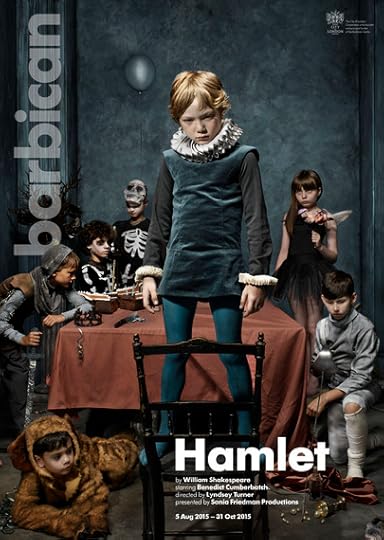
It really couldn't be anything else, could it? The must-see show of the year. Perhaps if the allure was just the Cumberbatch as the procrastinating Dane, this wouldn't be so high on my list. But with Lyndsey Turner directing and the talented Es Devlin doing the design, there is much to get excited about. Almost inevitably, all advance tickets have sold out but 100 £10 tickets will be made available for all performances at a later date so stay alert!
2. A View from the Bridge, Wyndhams's Theatre
(February 10 to April 11, 2015)
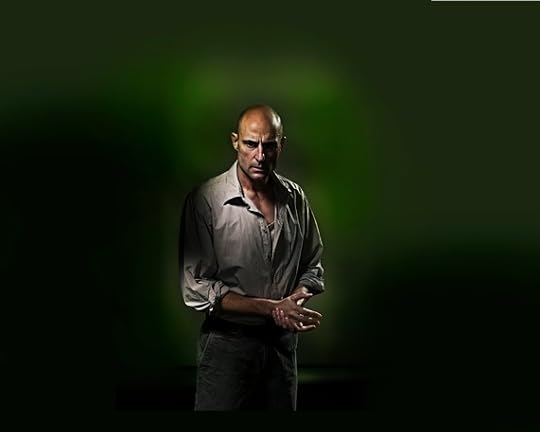
In my humble opinion, this was unquestionably the best production of 2014. Showing at the Young Vic, everything about this was extraordinary, from the direction by Ivo van Hove to the performance from Mark Strong. As word spread, it became impossible to get tickets so the show is transferring to the West End for a limited time.
If you didn't catch this production, I cannot recommend it enough. For those like me who have, it will be intriguing to see how this play transfers from the intimate confines of the Main Stage at the Young Vic.
3. 'The Kevin Spacey Play', Old Vic Theatre
(Dates unknown)
The show hasn't even been announced, it's not even confirmed that the world's most charismatic actor will be performing at the Old Vic next year but 2015 will be Mr Spacey's last year as Artistic Director and there are gaping holes in the Old Vic's calendar where shows have not yet been confirmed.
We're all expecting Spacey to be the lead in an as-yet unnamed production in his final year and my mother has already informed me I will be disowned if I don't get her a ticket. Pressure. In 2014 I saw his sold-out run of Clarence Darrow and the couple next to me had flown in from Spain to see the great man. Do not underestimate how fast these tickets will sell!
4. Antigone, Barbican Centre
(March 4 - 28, 2015)
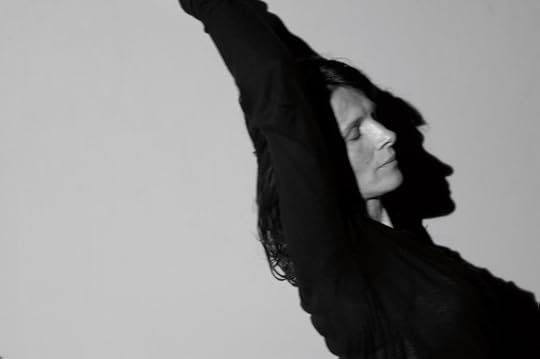
Greek tragedies can be a nightmare to produce as they are challenging for modern audiences what with their lack of sub-text and subtlety, but it will be intriguing to see what Ivo van Hove, fresh from wowing with A View from the Bridge, delivers.
And with Juliette Binoche as the ill-fated Antigone who defies her uncle to bury her brother, there is good reason to be excited. I already have my tickets.
5. Farinelli & the King, Sam Wanamaker Playhouse
(February 11 to March 8, 2015)
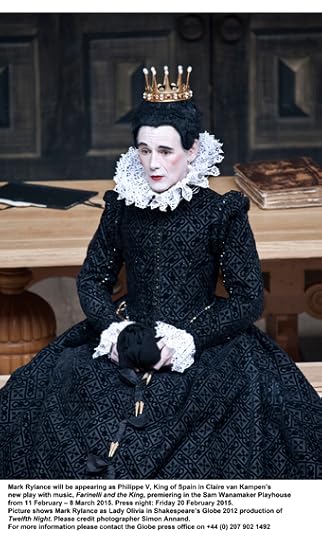
Ok, Mark Rylance. That's it. That's enough reason to grab what few tickets remain for this show running at the Playhouse at Shakespeare's Globe from February. There are, of course, other attractions - the new Playhouse is a sensual, intimate indoor theatre lit almost entirely by candlelight, which brings a powerful intimacy to their shows. But Mark Rylance, people. Come on! Get your tickets now.
6. Sweeney Todd, London Coliseum
(March 30 to April 12, 2015)
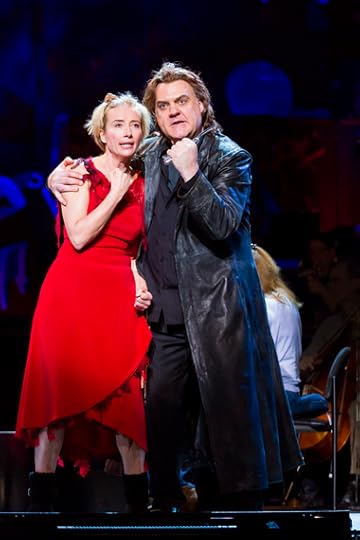
Emma Thompson and Bryn Terfel are both huge stars and they will be teaming up to create delicious meat pies in Sondheim's gruesome but glorious musical, Sweeney Todd.
It's an ingenious combination of opera and theatre. Given the high-quality cast it will be interesting to see what this production can bring to this well-known story, especially given a recently successful West-End run with Imelda Staunton and Michael Ball, and the high-profile film with Johnny Depp and Helena Bonham-Carter.
7. The Hard Problem, National Theatre
(January 21 to April 16, 2015)
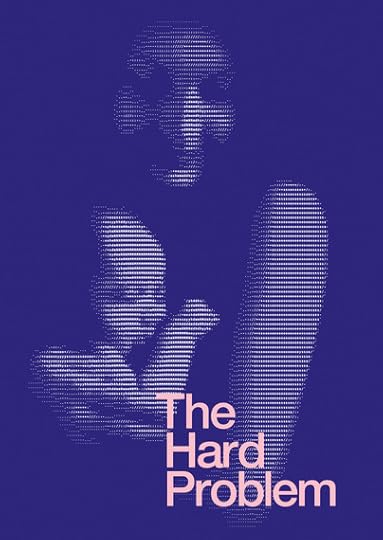
Tom Stoppard returns. And this play, his first since 2006, will be directed by Nicholas Hytner in his last year as Artistic Director. Intriguingly, this play will be showing in the National's intimate Dorfman Theatre rather than the larger Olivier. Sadly that means the run has already sold out but day tickets will be available.
8. Death of a Salesman, Royal Shakespeare Theatre
(March 26 to May 2, 2015)
A stellar cast has been brought together for this production of Arthur Miller's classic. Anthony Sher will be playing Willy Loman and he will be joined by the extraordinary Harriet Walter, who wowed (as she always does) in the Donmar's recent all-female Henry IV.
And they will be joined by Alex Hassell, who is currently playing Hal opposite Anthony Sher in Henry IV at the Barbican Centre. Their rapport was superb and I can't wait to see how they all work together. The quality of RSC productions is always high and this is unlikely to be an exception.
9. Gypsy, Savoy Theatre
(March 28 to July 18, 2015)
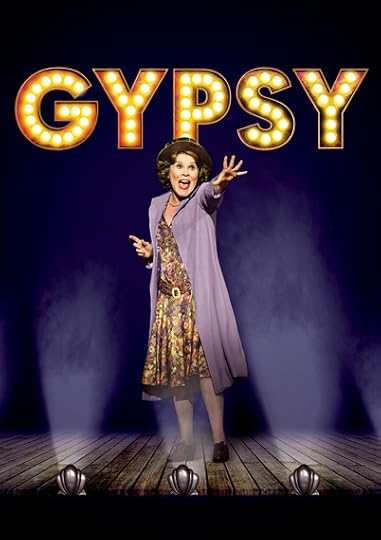
Critically acclaimed in its run at Chichester Festival, this show finally confirmed its West-End run only days ago. Imelda Staunton leads and her performance had critics and audiences alike drooling. She is coming with the transfer, along with her talented supporting cast including Lara Pulver and Kevin Whatley. Expect tickets to fly out the door for this, one of the famous Broadway shows ever.
10=. American Buffalo, Wyndham's Theatre
(April 16 to June 27, 2015)
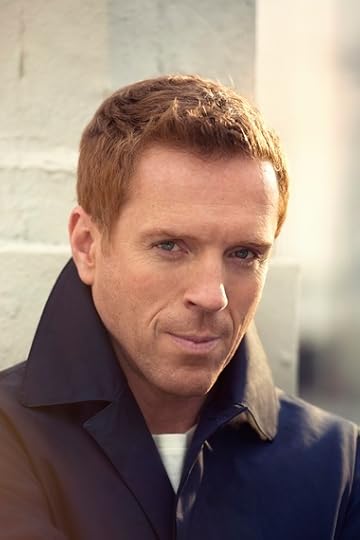
Damian Lewis in David Mamet. It's been five years since Damian Lewis was last in the West-End stage - and what a five years it has been for him. Now a global star on the screen, I'm looking forward to seeing him perform on the stage. The level of his fame though will make this ticket a popular grab again so if you want to go, you'll probably have to be quick!
10=. The Ruling Class, Trafalgar Transformed
(January 16 to April 11, 2015)
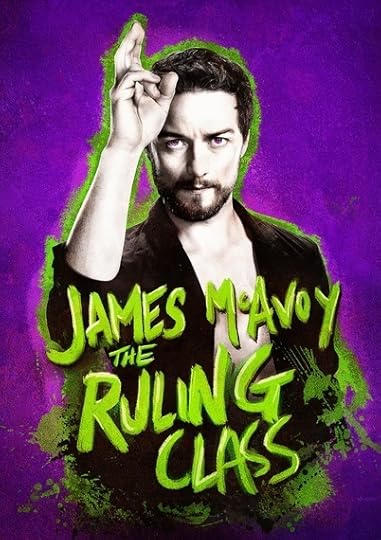
I had to squeeze this in, didn't I? James McAvoy returns to Trafalgar Studios to work once again with Jamie Lloyd, the man who directed him in the sell-out run of Macbeth earlier this year. They are joined again by Soutra Gilmour in design and they produced such an explosive, challenging Macbeth that I'm intrigued to see what they come up with in their new venture.
Image Credits:
1. Hamlet, Sonia Friedman Productions. Photographer Tim Gutt, Poster Art Direction Shona Heath.
2. Mark Strong in A View from the Bridge © Young Vic Theatre and Jan Versweyveld.
3. Ivo van Hove, Antigone, Juliette Binoche credit Peter Lindbergh
4. Farinelli and the King, Shakespeare's Globe. Photographer: Simon Annand
5. SweeneyTodd- Emma Thompson and Bryn Terfel © Chris Lee
6. The Hard Problem promotional image © National Theatre
7. Imelda Staunton as Rose, Gypsy promotional image based on photo by Johan Persson
8. Damian Lewis © Kurt Iswarienko
9. The Ruling Class promotional image © Trafalgar Transformed/Trafalgar Studios
Nevertheless, there is no doubting the appeal of the following 11 productions due in 2015 (I simply couldn't get the list down to just 10). So get to see these if you can - but never dismiss the possibility that the year's best play may, again, be an unanticipated gem!
1. Hamlet, Barbican Centre
(August 5 to October 31, 2015)

It really couldn't be anything else, could it? The must-see show of the year. Perhaps if the allure was just the Cumberbatch as the procrastinating Dane, this wouldn't be so high on my list. But with Lyndsey Turner directing and the talented Es Devlin doing the design, there is much to get excited about. Almost inevitably, all advance tickets have sold out but 100 £10 tickets will be made available for all performances at a later date so stay alert!
2. A View from the Bridge, Wyndhams's Theatre
(February 10 to April 11, 2015)

In my humble opinion, this was unquestionably the best production of 2014. Showing at the Young Vic, everything about this was extraordinary, from the direction by Ivo van Hove to the performance from Mark Strong. As word spread, it became impossible to get tickets so the show is transferring to the West End for a limited time.
If you didn't catch this production, I cannot recommend it enough. For those like me who have, it will be intriguing to see how this play transfers from the intimate confines of the Main Stage at the Young Vic.
3. 'The Kevin Spacey Play', Old Vic Theatre
(Dates unknown)
The show hasn't even been announced, it's not even confirmed that the world's most charismatic actor will be performing at the Old Vic next year but 2015 will be Mr Spacey's last year as Artistic Director and there are gaping holes in the Old Vic's calendar where shows have not yet been confirmed.
We're all expecting Spacey to be the lead in an as-yet unnamed production in his final year and my mother has already informed me I will be disowned if I don't get her a ticket. Pressure. In 2014 I saw his sold-out run of Clarence Darrow and the couple next to me had flown in from Spain to see the great man. Do not underestimate how fast these tickets will sell!
4. Antigone, Barbican Centre
(March 4 - 28, 2015)

Greek tragedies can be a nightmare to produce as they are challenging for modern audiences what with their lack of sub-text and subtlety, but it will be intriguing to see what Ivo van Hove, fresh from wowing with A View from the Bridge, delivers.
And with Juliette Binoche as the ill-fated Antigone who defies her uncle to bury her brother, there is good reason to be excited. I already have my tickets.
5. Farinelli & the King, Sam Wanamaker Playhouse
(February 11 to March 8, 2015)

Ok, Mark Rylance. That's it. That's enough reason to grab what few tickets remain for this show running at the Playhouse at Shakespeare's Globe from February. There are, of course, other attractions - the new Playhouse is a sensual, intimate indoor theatre lit almost entirely by candlelight, which brings a powerful intimacy to their shows. But Mark Rylance, people. Come on! Get your tickets now.
6. Sweeney Todd, London Coliseum
(March 30 to April 12, 2015)

Emma Thompson and Bryn Terfel are both huge stars and they will be teaming up to create delicious meat pies in Sondheim's gruesome but glorious musical, Sweeney Todd.
It's an ingenious combination of opera and theatre. Given the high-quality cast it will be interesting to see what this production can bring to this well-known story, especially given a recently successful West-End run with Imelda Staunton and Michael Ball, and the high-profile film with Johnny Depp and Helena Bonham-Carter.
7. The Hard Problem, National Theatre
(January 21 to April 16, 2015)

Tom Stoppard returns. And this play, his first since 2006, will be directed by Nicholas Hytner in his last year as Artistic Director. Intriguingly, this play will be showing in the National's intimate Dorfman Theatre rather than the larger Olivier. Sadly that means the run has already sold out but day tickets will be available.
8. Death of a Salesman, Royal Shakespeare Theatre
(March 26 to May 2, 2015)
A stellar cast has been brought together for this production of Arthur Miller's classic. Anthony Sher will be playing Willy Loman and he will be joined by the extraordinary Harriet Walter, who wowed (as she always does) in the Donmar's recent all-female Henry IV.
And they will be joined by Alex Hassell, who is currently playing Hal opposite Anthony Sher in Henry IV at the Barbican Centre. Their rapport was superb and I can't wait to see how they all work together. The quality of RSC productions is always high and this is unlikely to be an exception.
9. Gypsy, Savoy Theatre
(March 28 to July 18, 2015)

Critically acclaimed in its run at Chichester Festival, this show finally confirmed its West-End run only days ago. Imelda Staunton leads and her performance had critics and audiences alike drooling. She is coming with the transfer, along with her talented supporting cast including Lara Pulver and Kevin Whatley. Expect tickets to fly out the door for this, one of the famous Broadway shows ever.
10=. American Buffalo, Wyndham's Theatre
(April 16 to June 27, 2015)

Damian Lewis in David Mamet. It's been five years since Damian Lewis was last in the West-End stage - and what a five years it has been for him. Now a global star on the screen, I'm looking forward to seeing him perform on the stage. The level of his fame though will make this ticket a popular grab again so if you want to go, you'll probably have to be quick!
10=. The Ruling Class, Trafalgar Transformed
(January 16 to April 11, 2015)

I had to squeeze this in, didn't I? James McAvoy returns to Trafalgar Studios to work once again with Jamie Lloyd, the man who directed him in the sell-out run of Macbeth earlier this year. They are joined again by Soutra Gilmour in design and they produced such an explosive, challenging Macbeth that I'm intrigued to see what they come up with in their new venture.
Image Credits:
1. Hamlet, Sonia Friedman Productions. Photographer Tim Gutt, Poster Art Direction Shona Heath.
2. Mark Strong in A View from the Bridge © Young Vic Theatre and Jan Versweyveld.
3. Ivo van Hove, Antigone, Juliette Binoche credit Peter Lindbergh
4. Farinelli and the King, Shakespeare's Globe. Photographer: Simon Annand
5. SweeneyTodd- Emma Thompson and Bryn Terfel © Chris Lee
6. The Hard Problem promotional image © National Theatre
7. Imelda Staunton as Rose, Gypsy promotional image based on photo by Johan Persson
8. Damian Lewis © Kurt Iswarienko
9. The Ruling Class promotional image © Trafalgar Transformed/Trafalgar Studios
Published on December 26, 2014 16:00
December 22, 2014
Top 10 Art Shows of 2014
There have been some fantastic art exhibitions this year and the popularity of box office draws such as Rembrandt and Matisse warms the heart. However as I compiled this list, I couldn't help but notice that the list is dominated by white men - a sore reminder that diversity and representation remains a challenge that must be addressed (and luckily, 2015 looks like it will). But we'll leave that for later. For now, on with the list!
1. Anselm Kiefer, Royal Academy of Arts
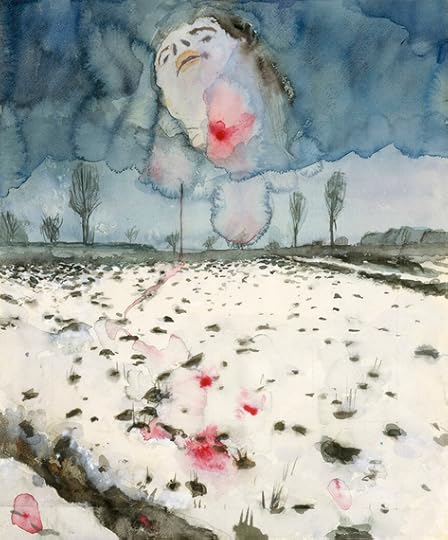
Anselm Kiefer is widely considered to be the most influential artist working today. And this show at the RA was the first ever retrospective of the great man's works in the UK.
Kiefer's works are vast both in scope and scale, from his blunt political works that confront Germany's Nazi past through to his vast canvases that look to capture the beauty but ever-changing evolution of our world and our universe.
The elegant high-ceilinged galleries of the RA were a perfect setting for Kiefer's work, giving visitors the space and time to take in and contemplate the extraordinary works in front of them.
2. Rembrandt: The Late Works, National Gallery
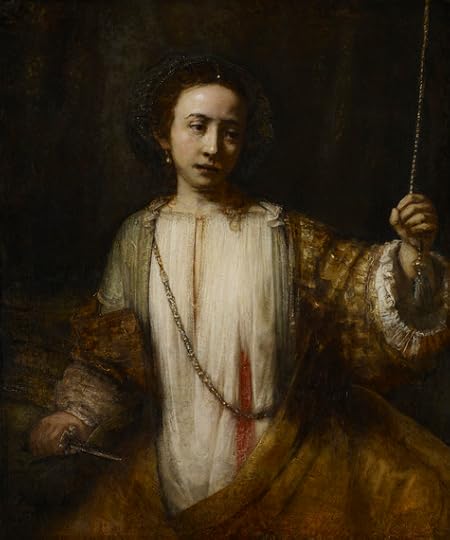
Simply put, there wasn't a finer collection of works on show this year than this focus on Rembrandt's later years at the National Gallery. Rembrandt may have been an impoverished painter in his later years but my god, his paintings take your breath away and show a man not only unflinching in his commitment to revolutionising his own technique but also a master in capturing human emotions, in depicting the conflicted mind.
So why is this exhibition not No. 1 in my list? Because the visitor experience was a shocker. The Sainsbury Wing's basement galleries may be intimate and cosy if there are low numbers but they became cramped and unbearable as the rooms became packed with the thousands of visitors who came in their droves. The popularity of this show was so predictable and it's frustrating the National Gallery didn't choose more spacious galleries for this show, like those chosen for Veronese.
3. Sigmar Polke: Alibis, Tate Modern
Nothing delights me more than an exhibition that takes me by surprise, and there wasn't a more surprising, more discombobulating show than this retrospective on Sigmar Polke.
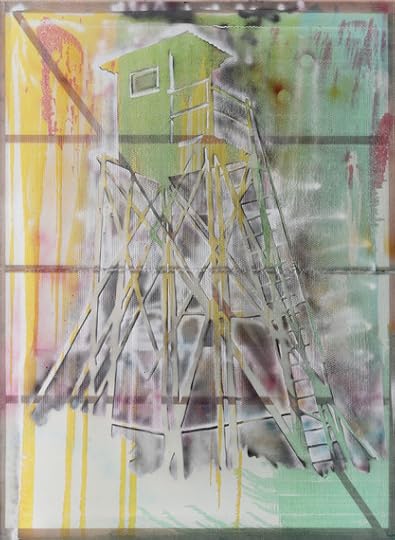
Polke's works almost defy explanation and even now, weeks after I visited, I still can't say that I understand many of them. But they challenge you, challenge your perspective, challenge your understanding of reality.
Whether it's the potatoes fixed on to garden furniture, or his blown-up, magnified, hyper-pixelated images he cut out from magazines, or his psychedelic images of Mao Tse-Tung on giant banners of fabric and works that fused sexualised and pornographic images with newspaper cuttings, nothing is as you expect. Glorious.
4. Veronese: Magnificence in Renaissance Venice, National Gallery
This exhibition at the National Gallery was the most significant collection of Veronese's works ever to be displayed in the United Kingdom. Veronese is not a household name like High Renaissance artists such as Leonardo, Michelangelo and Titian, but one visit to this exhibition showed how much he deserves his place alongside these Masters.
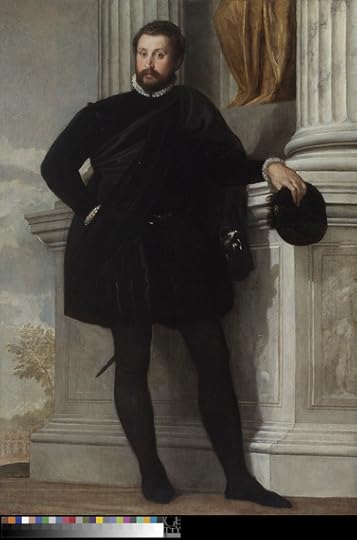
From the cool monochrome palette of his naturalistic portraits of nobles and aristocracy to his innovative compositions of works with more historical and biblical themes, the variety of Veronese's talents was incredibly impressive. This was a thrilling exhibition that shone a spotlight on an artist who is often overlooked.
5. Giovanni Battista Moroni, Royal Academy of Arts
Moroni is widely regarded as one of the finest painters of this 16th century but he's hardly a household name, often overshadowed by the more famous Italian painters of the time.
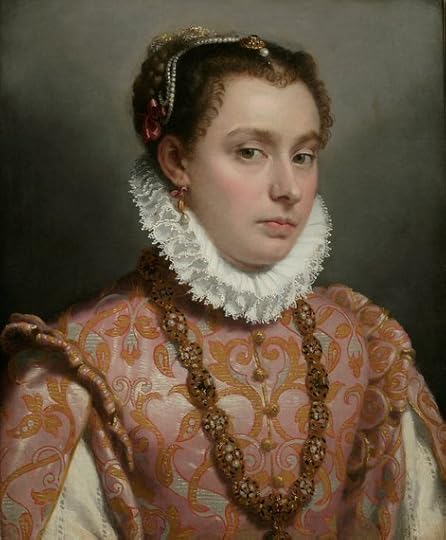
This exhibition at the RA, which is still open, is the first significant display of Moroni's works outside of Italy. His portraits were ahead of their time, naturalistic and full of insight and humanity so hopefully this show will go some way to giving Moroni greater recognition, which he richly deserves.
6. Kazimir Malevich, Tate Modern
Yes, Black Square was there. In fact, three versions of Malevich's game-changing masterpiece were on show. Black Square is stark but the rest of Malevich's work on show in this retrospective, the first for over 25 years, was brightly coloured and just as exciting.
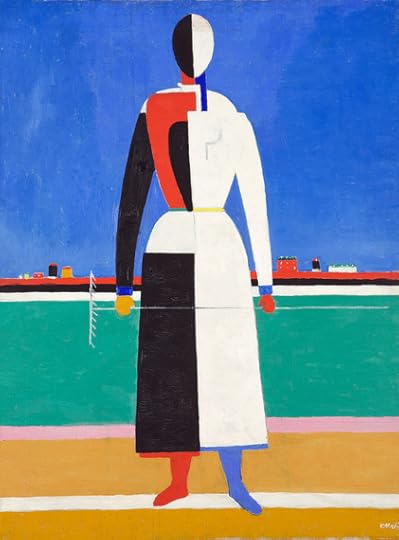
The Tate brought together a stunning collection of Malevich's work. That the Tate managed to secure so many precious loans from Russia is impressive in itself (and may go some way to explain how the Elgin Marbles have ended up in St Petersburg). But together these pieces offered not just an expansive view of this influential Russian artist's career but also put into context how radical and revolutionary Malevich was.
7. Henri Matisse: The Cut-Outs, Tate Modern
The big art exhibition of the summer, visitors flocked in their thousands to see the most comprehensive display of Matisse's paper cut-outs. It was impossible not to be impacted by these fun, vibrant works. I'm not Matisse's biggest fan but I felt such joy, such a sense of happiness, from admiring these brightly coloured works.
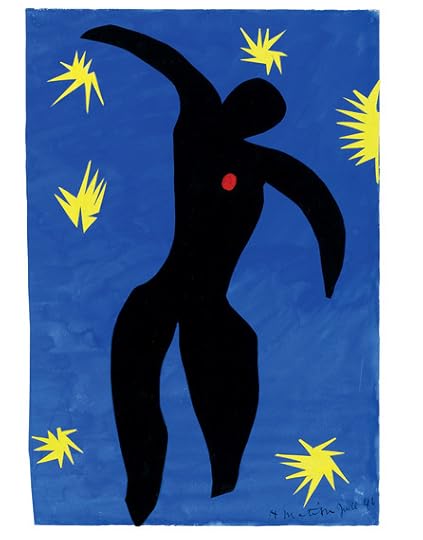
I'd only seen these cutouts in isolation before - a piece here, a piece there. Yet here, with the pieces brought together, you could fully appreciate what Matisse was achieving. To stand in front of these huge colourful compositions was a wonderful experience. Truly uplifting.
8. Radical Geometry: South American Art, Royal Academy of Arts
The third exhibition from the RA in this list and it's well deserved. The RA has had a cracking year, mixing big names such as Dennis Hopper and Allen Jones with surprising, revelatory shows on lesser known works, such as this collection of 20th century South American art.
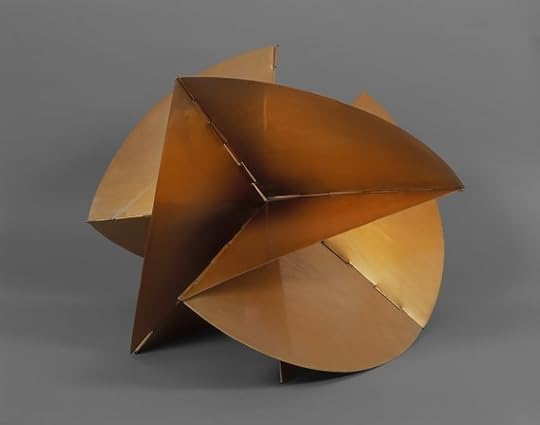
I had expected the works on show to be heavy with political slogans and messages. Not at all. The art on show was stunning, vibrant and completely unexpected. The works were unconventional and showed communities of artists rejecting influences from Europe and looking to develop a radical geometric style of their own in both painting and sculpture.
9. Egon Schiele: The Radical Nude, The Courtauld Gallery
Art will always be controversial and there is plenty of controversy attached to Schiele's nudes. His work radicalised the way nudes, in particular female nudes, are represented in art.
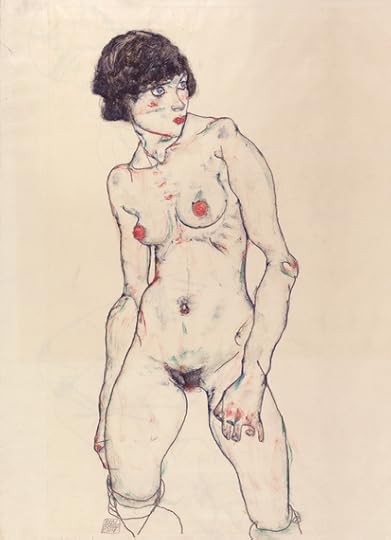
Gone was the conventional depiction of naked women as passive objects of perfect beauty, idealised and idolised for male consumption. Instead, Schiele's female nudes are snarling, confrontational models. And they are glorious. Their bodies almost sculptural with their strong physical presence, emphasised by Schiele's bold strokes, his fearless compositions, and his splash of bright colour to emphasise their sexual arousal.
More tricky are the sexualised drawings and paintings of his younger sister, Gerti, with whom Schiele had an incestuous relationship in his younger years. It's good that art doesn't censor itself but it is uncomfortable looking at sexualised images of 14 year old girls.
10. The Human Factor, Hayward Gallery
The Hayward Gallery was rightly nominated for the Art Fund prize of Museum of the Year and its galleries were the perfect venue for this exhibition of contemporary works that looked at how leading artists have explored and fashioned new ways of using the human form in sculpture.
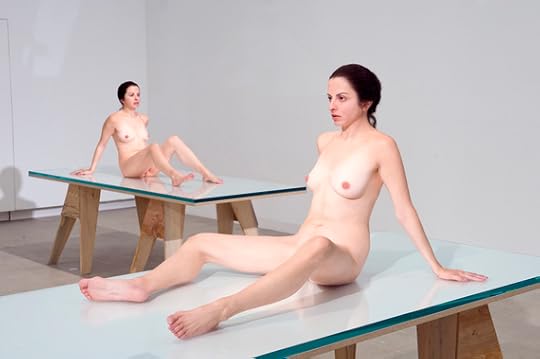
The works on show were from 25 leading international artists and spanned the past 25 years. Some of them were funny, some were traumatic. Some of the pieces seemed so real, so true to life you could be forgiven for believing you were looking at a living statue. But collectively they were a terrific and thought-provoking showcase that used the figure to reflect such far-ranging concerns as voyeurism, sexuality, violence, mass consumerism and even morality.
Image Credits:
1. Anselm Kiefer Winter Landscape (Winterlandschaft), 1970 Watercolour, gouache, and graphite pencil on paper, 42.9 x 35.6 cm Lent by the Metropolitan Museum of Art, Denise and Andrew Saul Fund, 1995 (1995.14.5) Photo copyright 2014. Image copyright The Metropolitan Museum of Art/Art Resource/Scala, Florence / copyright Anselm Kiefer
2. Rembrandt The Suicide of Lucretia, 1666 Oil on canvas 109 x 93 cm Minneapolis Institute of Arts, The William Hood Dunwoody Fund 34.19 © The Minneapolis Institute of Arts, Minnesota
3. Watchtower (Hochsitz) 1984 IVAM, Institut Valencia d'Art Modern, Valencia, Spain © The Estate of Sigmar Polke / DACS, London / VG Bild-Kunst, Bonn
4. Paolo Veronese (1528-1588) Portrait of a Gentleman, about 1560-5 Oil on canvas 192.1 × 134 cm © The J. Paul Getty Museum, Los Angeles
5. Giovanni Battista Moroni Young Lady, c.1560-65 Oil on canvas, 51 x 42 cm Private collection Photo: Private collection
6. Kazimir Malevich, Woman with Rake 1930-32 © State Tretyakov Gallery, Moscow, Russia
7. Henri Matisse, Icarus 1946 Maquette for plate VIII of the illustrated book Jazz 1947 © Centre Pompidou, MNAM-CCI, Dist. RMN-Grand Palais / Jean-Claude Planchet, and © Succession Henri Matisse/DACS 2014
8. Lygia Clark Machine â?? Medium, 1962 Golden aluminum, approx. 48.2 x 66.1 x 61 cm Coleccion Patricia Phelps de Cisneros c. The World of Lygia Clark Cultural Association
9. Egon Schiele (1890-1918) Standing Nude with Stockings, 1914 Black chalk and gouache 48.5 x 32.1 cm Germanisches Nationalmuseum, Nuremburg
10. Paul McCarthy, That Girl (T.G. Awake), 2012-2013 (detail), Installation view, The Human Factor, Hayward Gallery 2014, Photo Linday Nylind © Paul McCarthy
1. Anselm Kiefer, Royal Academy of Arts

Anselm Kiefer is widely considered to be the most influential artist working today. And this show at the RA was the first ever retrospective of the great man's works in the UK.
Kiefer's works are vast both in scope and scale, from his blunt political works that confront Germany's Nazi past through to his vast canvases that look to capture the beauty but ever-changing evolution of our world and our universe.
The elegant high-ceilinged galleries of the RA were a perfect setting for Kiefer's work, giving visitors the space and time to take in and contemplate the extraordinary works in front of them.
2. Rembrandt: The Late Works, National Gallery

Simply put, there wasn't a finer collection of works on show this year than this focus on Rembrandt's later years at the National Gallery. Rembrandt may have been an impoverished painter in his later years but my god, his paintings take your breath away and show a man not only unflinching in his commitment to revolutionising his own technique but also a master in capturing human emotions, in depicting the conflicted mind.
So why is this exhibition not No. 1 in my list? Because the visitor experience was a shocker. The Sainsbury Wing's basement galleries may be intimate and cosy if there are low numbers but they became cramped and unbearable as the rooms became packed with the thousands of visitors who came in their droves. The popularity of this show was so predictable and it's frustrating the National Gallery didn't choose more spacious galleries for this show, like those chosen for Veronese.
3. Sigmar Polke: Alibis, Tate Modern
Nothing delights me more than an exhibition that takes me by surprise, and there wasn't a more surprising, more discombobulating show than this retrospective on Sigmar Polke.

Polke's works almost defy explanation and even now, weeks after I visited, I still can't say that I understand many of them. But they challenge you, challenge your perspective, challenge your understanding of reality.
Whether it's the potatoes fixed on to garden furniture, or his blown-up, magnified, hyper-pixelated images he cut out from magazines, or his psychedelic images of Mao Tse-Tung on giant banners of fabric and works that fused sexualised and pornographic images with newspaper cuttings, nothing is as you expect. Glorious.
4. Veronese: Magnificence in Renaissance Venice, National Gallery
This exhibition at the National Gallery was the most significant collection of Veronese's works ever to be displayed in the United Kingdom. Veronese is not a household name like High Renaissance artists such as Leonardo, Michelangelo and Titian, but one visit to this exhibition showed how much he deserves his place alongside these Masters.

From the cool monochrome palette of his naturalistic portraits of nobles and aristocracy to his innovative compositions of works with more historical and biblical themes, the variety of Veronese's talents was incredibly impressive. This was a thrilling exhibition that shone a spotlight on an artist who is often overlooked.
5. Giovanni Battista Moroni, Royal Academy of Arts
Moroni is widely regarded as one of the finest painters of this 16th century but he's hardly a household name, often overshadowed by the more famous Italian painters of the time.

This exhibition at the RA, which is still open, is the first significant display of Moroni's works outside of Italy. His portraits were ahead of their time, naturalistic and full of insight and humanity so hopefully this show will go some way to giving Moroni greater recognition, which he richly deserves.
6. Kazimir Malevich, Tate Modern
Yes, Black Square was there. In fact, three versions of Malevich's game-changing masterpiece were on show. Black Square is stark but the rest of Malevich's work on show in this retrospective, the first for over 25 years, was brightly coloured and just as exciting.

The Tate brought together a stunning collection of Malevich's work. That the Tate managed to secure so many precious loans from Russia is impressive in itself (and may go some way to explain how the Elgin Marbles have ended up in St Petersburg). But together these pieces offered not just an expansive view of this influential Russian artist's career but also put into context how radical and revolutionary Malevich was.
7. Henri Matisse: The Cut-Outs, Tate Modern
The big art exhibition of the summer, visitors flocked in their thousands to see the most comprehensive display of Matisse's paper cut-outs. It was impossible not to be impacted by these fun, vibrant works. I'm not Matisse's biggest fan but I felt such joy, such a sense of happiness, from admiring these brightly coloured works.

I'd only seen these cutouts in isolation before - a piece here, a piece there. Yet here, with the pieces brought together, you could fully appreciate what Matisse was achieving. To stand in front of these huge colourful compositions was a wonderful experience. Truly uplifting.
8. Radical Geometry: South American Art, Royal Academy of Arts
The third exhibition from the RA in this list and it's well deserved. The RA has had a cracking year, mixing big names such as Dennis Hopper and Allen Jones with surprising, revelatory shows on lesser known works, such as this collection of 20th century South American art.

I had expected the works on show to be heavy with political slogans and messages. Not at all. The art on show was stunning, vibrant and completely unexpected. The works were unconventional and showed communities of artists rejecting influences from Europe and looking to develop a radical geometric style of their own in both painting and sculpture.
9. Egon Schiele: The Radical Nude, The Courtauld Gallery
Art will always be controversial and there is plenty of controversy attached to Schiele's nudes. His work radicalised the way nudes, in particular female nudes, are represented in art.

Gone was the conventional depiction of naked women as passive objects of perfect beauty, idealised and idolised for male consumption. Instead, Schiele's female nudes are snarling, confrontational models. And they are glorious. Their bodies almost sculptural with their strong physical presence, emphasised by Schiele's bold strokes, his fearless compositions, and his splash of bright colour to emphasise their sexual arousal.
More tricky are the sexualised drawings and paintings of his younger sister, Gerti, with whom Schiele had an incestuous relationship in his younger years. It's good that art doesn't censor itself but it is uncomfortable looking at sexualised images of 14 year old girls.
10. The Human Factor, Hayward Gallery
The Hayward Gallery was rightly nominated for the Art Fund prize of Museum of the Year and its galleries were the perfect venue for this exhibition of contemporary works that looked at how leading artists have explored and fashioned new ways of using the human form in sculpture.

The works on show were from 25 leading international artists and spanned the past 25 years. Some of them were funny, some were traumatic. Some of the pieces seemed so real, so true to life you could be forgiven for believing you were looking at a living statue. But collectively they were a terrific and thought-provoking showcase that used the figure to reflect such far-ranging concerns as voyeurism, sexuality, violence, mass consumerism and even morality.
Image Credits:
1. Anselm Kiefer Winter Landscape (Winterlandschaft), 1970 Watercolour, gouache, and graphite pencil on paper, 42.9 x 35.6 cm Lent by the Metropolitan Museum of Art, Denise and Andrew Saul Fund, 1995 (1995.14.5) Photo copyright 2014. Image copyright The Metropolitan Museum of Art/Art Resource/Scala, Florence / copyright Anselm Kiefer
2. Rembrandt The Suicide of Lucretia, 1666 Oil on canvas 109 x 93 cm Minneapolis Institute of Arts, The William Hood Dunwoody Fund 34.19 © The Minneapolis Institute of Arts, Minnesota
3. Watchtower (Hochsitz) 1984 IVAM, Institut Valencia d'Art Modern, Valencia, Spain © The Estate of Sigmar Polke / DACS, London / VG Bild-Kunst, Bonn
4. Paolo Veronese (1528-1588) Portrait of a Gentleman, about 1560-5 Oil on canvas 192.1 × 134 cm © The J. Paul Getty Museum, Los Angeles
5. Giovanni Battista Moroni Young Lady, c.1560-65 Oil on canvas, 51 x 42 cm Private collection Photo: Private collection
6. Kazimir Malevich, Woman with Rake 1930-32 © State Tretyakov Gallery, Moscow, Russia
7. Henri Matisse, Icarus 1946 Maquette for plate VIII of the illustrated book Jazz 1947 © Centre Pompidou, MNAM-CCI, Dist. RMN-Grand Palais / Jean-Claude Planchet, and © Succession Henri Matisse/DACS 2014
8. Lygia Clark Machine â?? Medium, 1962 Golden aluminum, approx. 48.2 x 66.1 x 61 cm Coleccion Patricia Phelps de Cisneros c. The World of Lygia Clark Cultural Association
9. Egon Schiele (1890-1918) Standing Nude with Stockings, 1914 Black chalk and gouache 48.5 x 32.1 cm Germanisches Nationalmuseum, Nuremburg
10. Paul McCarthy, That Girl (T.G. Awake), 2012-2013 (detail), Installation view, The Human Factor, Hayward Gallery 2014, Photo Linday Nylind © Paul McCarthy
Published on December 22, 2014 16:00
December 17, 2014
Exhibition: Giovanni Battista Moroni, Royal Academy of Arts
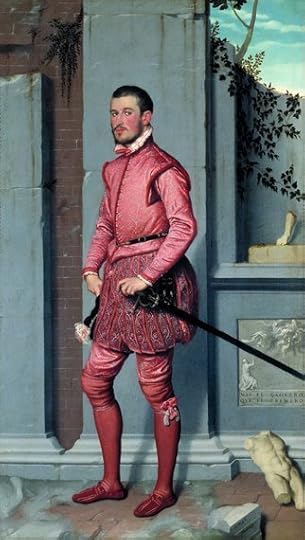
Moroni is widely regarded as one of the finest painters of the 16th century, and a critical innovator in portraiture, in particular. Yet his name is not widely known by the general public so this new exhibition at the Royal Academy, the first ever large-scale display of his work outside Italy, is an important contribution in correcting this.
Moroni, born in Albino in c. 1520, spent most of his days working in and around Bergamo in Northern Italy at a time when most Italian artists headed to Venice. Being away from the centre of all things often meant his work was overlooked or marginalised, both at the time and subsequently.
Yet by working in Bergamo, Moroni established himself as the main figures of Lombard art, a style that replaced the idealisation and artifice that dominated portraiture at the time that with a more realistic, more natural and character-revealing style.
And his tremendous skills are laid out for all to see in the 45 paintings that the Royal Academy has brought together in this show.
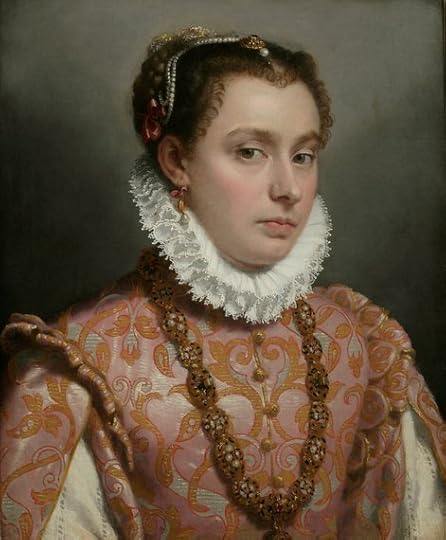
Moroni could capture the inner life of his sitters as much as replicating their likeness. His portraits are infused with such penetrative insight as well as wonderful observation of the changing fashion such as the sudden penchant for open sleeves. But what really exalts his work is its realism.
Sitters are slouched in chairs or casually leaning against plinths or walls. Sometimes their gaze is direct- are they intimidating their audience or curious about their presence? Other times the sitters are gazing off into the distance, lost in their own thoughts.
Moroni painted not just the political elite in the region where he lived but also poets, tailors and even anonymous people he simply wanted to capture in his work. Yet all of them are given the opportunity to pose as if for state portraits, in either full length paintings or in close up three-quarter style.
Taking Young Lady above as just an example, the exquisite detail in her dazzling jewels that catch the light, the intricacies of her lace collar and the detail of her rich robes are all there. But what draws us in are her eyes.
Her head is bathed in a soft light that causes us to focus on her face. And that tilt of her head and the inquisitiveness if her gaze is intriguing. It's as if we're forming a relationship with her rather than passively over serving her. Her portrait is immediate and intimate.
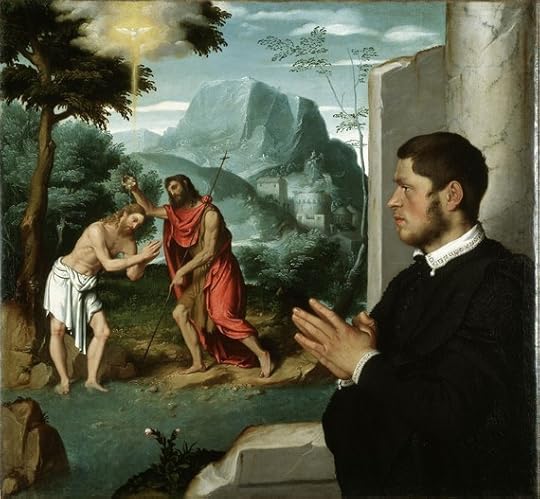
Moroni also did many religious works. He was very much involved in the Counter-Reformation movement, which sought to redress and revitalise Catholic imagery in the face of Protestant criticism.
Some of these works are included in the exhibition, such as A Gentleman in Adoration before the Baptism of Christ above. Paintings such as these, where devotional prayer could conjure up visions of a sacred scene reflected popular Catholic doctrine of the time yet Moroni still left his mark on the interpretation.
The austere pious demeanour and wardrobe of the man in contemplation is in stark contrast with the bright colours of the religious scene he witnesses. And Moroni's composition, with the gentleman in the foreground yet his focus being not on us but on John baptising Jesus, draws us in.
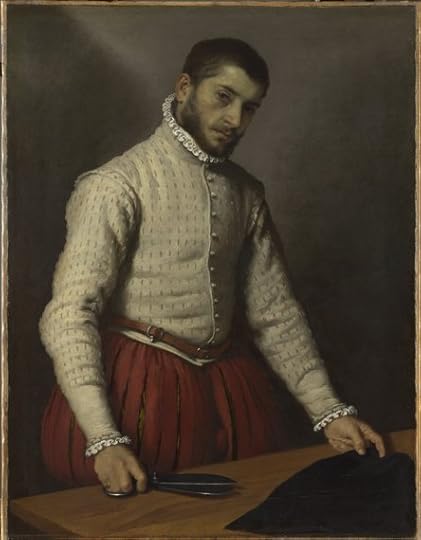
The exhibition ends with, perhaps, Moroni's finest painting The Tailor (1565-70). The man in the painting is unknown - is he an aristocrat who ended up selling fabric or is he a wealthy tailor who was responsible for dressing the elite? But in this painting, all of Moroni's profound skills are on display.
The muted tonal effects of the painting, with the faded rusty red and the warm browns offset by the silvery tones in the grey background and the man's ivory shirt, are exquisite and in such sharp contrast with the bright colours of the more Venetian style of portraiture.
The sharp steel of the scissors catch the eye, drawing us in to a man at work rather than a man posing for a picture. His head is angled towards us, as if we're interrupting him. And this tilt of the head and the inquisitive gaze are all so much more intriguing. And with the pale parlour of his skin and his pursed lips, much more natural than the more contrived sittings prevalent elsewhere.
Moroni's portraiture, with its psychological slant and unprecedented realism, was ahead of its time. This exhibition at the Royal Academy rightly puts his talents back in the spotlight and hopefully goes far in furthering people's knowledge and appreciation of this fine artist. It certainly has with me.
Royal Academy of Arts, London to January 25, 2015
Admission: £13.50 (concessions available)
Image Credits:
1. Giovanni Battista Moroni Gian Gerolamo Grumelli, c. 1560 Oil on canvas, 216 x 123 cm Fondazione Museo di Palazzo Moroni - Lucretia Moroni Collection, Bergamo. Photo Fondazione Museo di Palazzo Moroni - Lucretia Moroni Collection, Bergamo. Photography: Marco Mazzoleni.
2. Giovanni Battista Moroni Young Lady, c.1560-65 Oil on canvas, 51 x 42 cm Private collection Photo: Private collection
3. Giovanni Battista Moroni A Gentleman in Adoration before the Baptism of Christ, c.1555-60 Oil on canvas, 112.8 x 104 cm Gerolamo and Roberta Etro Photo: Gerolamo and Roberta Etro
4. Giovanni Battista Moroni The Tailor, c. 1570 Oil on canvas, 99.5 x 77 cm The National Gallery, London Photo c. The National Gallery, London
Published on December 17, 2014 11:42
December 12, 2014
Review: Henry IV Parts One and Two, Royal Shakespeare Company
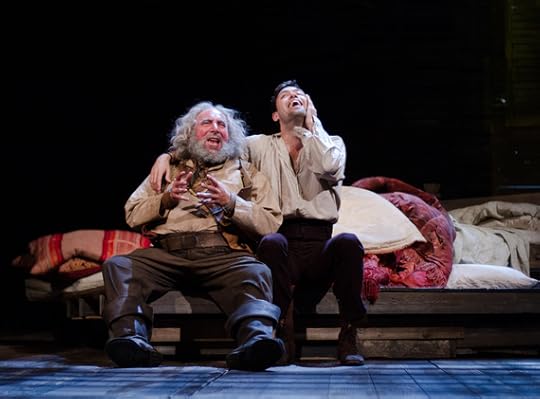
The quality of RSC productions is always sky high and this interpretation of Shakespeare's most venerated play at the Barbican Centre is no exception.
Henry IV tells the story of the King, who many feel usurped the throne from Richard II, as he battles to weld together a nation riven with cliques, conspiracies and competing ambitions. Yet there's so much more going on in this extraordinary play as Shakespeare examines the politics of war and the price ordinary people are forced to pay for squabbles amongst the nobility.
And within this story is another story, that of the rise of Henry's son Hal to both the Crown and its responsibilities. We watch as the wayward Prince learns to shed the jovial criminality of his truant life with the charismatic Sir John Falstaff and go on to become the adored Henry V.
Anthony Sher is the star casting as Falstaff and, of course, he is superb. Everything about his performance is superb - the delivery, the warmth, Falstaff's arrogance and his manipulation of those around him, and that great speech on the eve of war on the perversity of honour is moving and powerful.
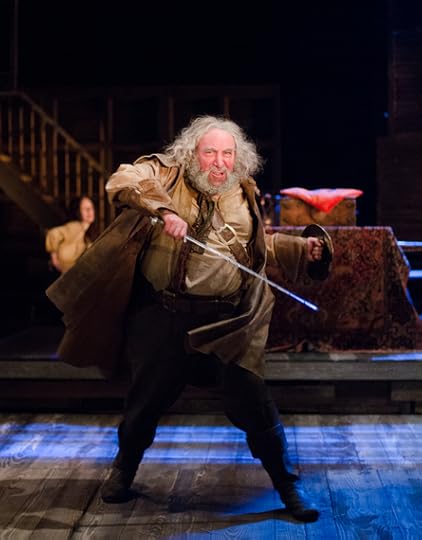
But in addition to Anthony Sher, Alex Hassell and Trevor White wow as the two Harrys. Alex Hassell's juvenile but charismatic Hal is good-looking, smart and physically fit but there's also inner turmoil, that inability to face up to the responsibilities of his position. There is so much going on behind his eyes.
And that complexity is matched by Trevor White's Percy, the warrior would-be Prince who is leading the insurrection against the King. His blood-lust and rage is palpable but also masks moments of real vulnerability.
The rapport between Anthony Sher's Falstaff and Alex Hassell's Hal is one of the best I've ever seen. There is such a warm connection between them and the pacing of their break as it starts to weaken then snap, is absolutely perfect.
You sense a great deal of anger in Hal at Falstaff's appropriation of the kill at the Battle of Shrewsbury and that betrayal, you sense, is the key moment in the unravelling of their father-son rapport.
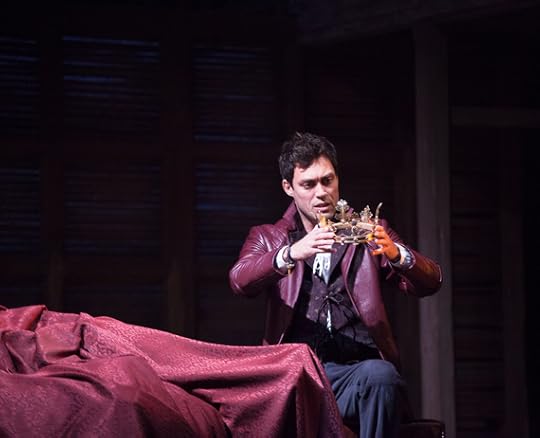
The direction comes from Gregory Doran and it is sharp, perfectly balanced and has some wonderful moments. He demonstrates beautifully the contrast between Hal and Falstaff as Alex Hassell's youthful, energetic Hal bounces around the hobbling, ageing Falstaff.
And in an interesting merging of scene transitions, there's a fascinating moment where the two Harrys unconsciously circle each other, foreshadowing what will come to pass.
This is very much a traditional production with the stripped floorboards, glistening armour, full-blooded battle scenes and glorious music. There's a jarring moment when Rumour starts Part 2 dressed in a Rolling Stones t-shirt in front of a backdrop of Twitter hashtags and mobile phone ringtones but this soon passes.
The set design from Stephen Brimson Lewis is glorious with the warmth of the tavern brilliantly contrasted with the chill of the Royal Court. And I particularly liked the evocative jagged tear that rips across the backdrop, reflecting superbly the violent schisms and personal battles that run through this play.
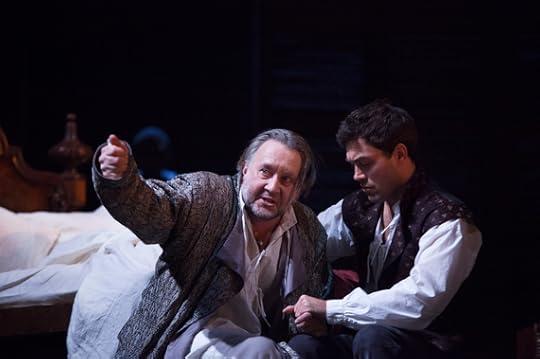
Together the running time for these two shows comes in at six hours. Coming so soon after Phyllida Lloyd's innovative abbreviated version at the Donmar Warehouse, I feared that this more traditional full-length version of the play might seem bloated and heavy in comparison. Not at all, this production zips with energy and life.
There's a perfect balance of humour and pathos and all the sufferings and terrible exploitation of the King's wars on his people in war is reflected beautifully and very movingly.
Stunning, stunning, stunning. I cannot recommend this play enough.
Barbican Centre, London to January 24, 2015
Image Credits:
1. Henry IV Part I, 2014, Antony Sher (Sir John Falstaff) and Alex Hassell (Prince Hal) © RSC. Photography by Kwame Lestrade
2. Henry IV Part I, 2014, Antony Sher (Sir John Falstaff) © RSC. Photography by Kwame Lestrade
3. Henry IV Part II, 2014, Alex Hassell (Hal) © RSC. Photography by Kwame Lestrade
4. Henry IV Part II, 2014, Jasper Britton (King Henry IV) and Alex Hassell (Hal) © RSC. Photography by Kwame Lestrade
Blogger has permission to use all images in this post.
Published on December 12, 2014 06:09



